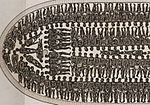Slavery
| Part of a series on |
| Forced labour and slavery |
|---|
 |
Slavery is the ownership of a person as property, especially in regards to their labour.[1] Slavery typically involves compulsory work, with the slave's location of work and residence dictated by the party that holds them in bondage. Enslavement is the placement of a person into slavery, and the person is called a slave or an enslaved person (see § Terminology).
Many historical cases of enslavement occurred as a result of breaking the law, becoming indebted, suffering a military defeat, or exploitation for cheaper labor; other forms of slavery were instituted along demographic lines such as race or sex. Slaves may be kept in bondage for life, or for a fixed period of time after which they would be granted freedom.[2] Although slavery is usually involuntary and involves coercion, there are also cases where people voluntarily enter into slavery to pay a debt or earn money due to poverty. In the course of human history, slavery was a typical feature of civilization,[3] and was legal in most societies, but it is now outlawed in most countries of the world, except as a punishment for a crime.[4][5]
In chattel slavery, the slave is legally rendered the personal property (chattel) of the slave owner. In economics, the term de facto slavery describes the conditions of unfree labour and forced labour that most slaves endure.[6]

Mauritania was the last country in the world to officially ban slavery, in 1981,[7] with legal prosecution of slaveholders established in 2007.[8] However, in 2019, approximately 40 million people, of whom 26% were children, were still enslaved throughout the world despite slavery being illegal. In the modern world, more than 50% of slaves provide forced labour, usually in the factories and sweatshops of the private sector of a country's economy.[9] In industrialised countries, human trafficking is a modern variety of slavery; in non-industrialised countries, debt bondage is a common form of enslavement,[6] such as captive domestic servants, people in forced marriages, and child soldiers.[10]
Etymology
The word slave was borrowed into Middle English through the Old French esclave which ultimately derives from Byzantine Greek σκλάβος (sklábos) or εσκλαβήνος (ésklabḗnos).
According to the widespread view, which has been known since the 18th century, the Byzantine Σκλάβινοι (Sklábinoi), Έσκλαβηνοί (Ésklabēnoí), borrowed from a Slavic tribe self-name *Slověne, turned into σκλάβος, εσκλαβήνος (Late Latin sclāvus) in the meaning 'prisoner of war slave', 'slave' in the 8th/9th century, because they often became captured and enslaved.[11][12][13][14] However this version has been disputed since the 19th century.[15][16]
An alternative contemporary hypothesis states that Medieval Latin sclāvus via *scylāvus derives from Byzantine σκυλάω (skūláō, skyláō) or σκυλεύω (skūleúō, skyleúō) with the meaning "to strip the enemy (killed in a battle)" or "to make booty / extract spoils of war".[17][18][19][20] This version has been criticized as well.[21]
Terminology
There is a dispute among historians about whether terms such as "unfree labourer" or "enslaved person", rather than "slave", should be used when describing the victims of slavery. According to those proposing a change in terminology, slave perpetuates the crime of slavery in language by reducing its victims to a nonhuman noun instead of "carry[ing] them forward as people, not the property that they were" (see also People-first language). Other historians prefer slave because the term is familiar and shorter, or because it accurately reflects the inhumanity of slavery, with person implying a degree of autonomy that slavery does not allow.[22]
Chattel slavery
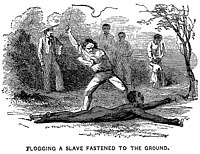
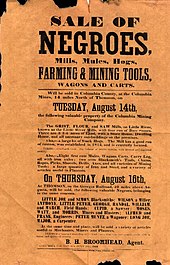
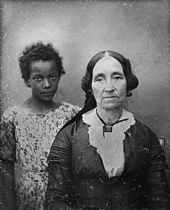
As a social institution, chattel slavery classes slaves as chattels (personal property) owned by the enslaver; like livestock, they can be bought and sold at will.[23] Chattel slavery was historically the normal form of slavery and was practiced in places such as the Roman Empire and classical Greece, where it was considered a keystone of society.[24][25][26] Other places where it was extensively practiced include Medieval Egypt,[27] Subsaharan Africa,[28] Brazil, the United States and parts of the Caribbean such as Cuba and Haiti.[29][30] The Iroquois enslaved others in ways that “looked very like chattel slavery."[31]
Beginning in the 18th century, a series of abolitionist movements saw slavery as a violation of the slaves' rights as people ("all men are created equal"), and sought to abolish it. Abolitionism encountered extreme resistance but was eventually successful. Several of the states of the United States began abolishing slavery during the American Revolutionary War. The French Revolution tried to abolish slavery in 1794, but a permanent abolition did not occur until 1848. In the much of the British Empire, slavery was subject to abolition in 1833, throughout the United States it was abolished in 1865 and in Cuba in 1886. The last country in the Americas to abolish slavery was Brazil, in 1888.[32]
Chattel slavery survived longest in the Muslim Middle East. After the Trans-Atlantic slave trade had been suppressed, the ancient Trans-Saharan slave trade, the Indian Ocean slave trade and the Red Sea slave trade continued to traffic slaves from the African continent to the Middle East. During the 20th century, the issue of chattel slavery was addressed and investigated globally by international bodies created by the League of Nations and the United Nations, such as the Temporary Slavery Commission in 1924–1926, the Committee of Experts on Slavery in 1932, and the Advisory Committee of Experts on Slavery in 1934–1939.[33] By the time of the UN Ad Hoc Committee on Slavery in 1950–1951, legal chattel slavery still existed only in the Arabian Peninsula: in Oman, in Qatar, in Saudi Arabia, in the Trucial States and in Yemen.[33] Legal chattel slavery was finally abolished in the Arabian Peninsula in the 1960s: Saudi Arabia and Yemen in 1962, in Dubai in 1963, and Oman as the last in 1970.[33]
The last country to abolish slavery, Mauritania, did so in 1981. The 1981 ban on slavery was not effectively enforced in practice, as there were no legal mechanisms to prosecute those who used slaves. This only came in 2007.
Bonded labour
Indenture, also known as bonded labour or debt bondage, is a form of unfree labour in which a person works to pay off a debt by pledging himself or herself as collateral. The services required to repay the debt, and their duration, may be undefined. Debt bondage can be passed on from generation to generation, with children required to pay off their progenitors' debt.[34] It is the most widespread form of slavery today.[35] Debt bondage is most prevalent in South Asia.[34] Money marriage refers to a marriage where a girl, usually, is married off to a man to settle debts owed by her parents.[36] The Chukri system is a debt bondage system found in parts of Bengal where a female can be coerced into prostitution in order to pay off debts.[37]
Dependents
The word slavery has also been used to refer to a legal state of dependency to somebody else.[38][39] For example, in Persia, the situations and lives of such slaves could be better than those of common citizens.[40]

Forced labour
Forced labour, or unfree labour, is sometimes used to describe an individual who is forced to work against their own will, under threat of violence or other punishment. This may also include institutions not commonly classified as slavery, such as serfdom, conscription and penal labour. As slavery has been legally outlawed in all countries, forced labour in the present day (frequently referred to as "modern slavery") revolves around illegal control.
Human trafficking primarily involves women and children forced into prostitution and is the fastest growing form of forced labour, with Thailand, Cambodia, India, Brazil and Mexico having been identified as leading hotspots of commercial sexual exploitation of children.[41][42]
Child soldiers and child labour
In 2007, Human Rights Watch estimated that 200,000 to 300,000 children served as soldiers in then-current conflicts.[43] More girls under 16 work as domestic workers than any other category of child labour, often sent to cities by parents living in rural poverty as with the Haitian restaveks.[44]
Forced marriage
Forced marriages or early marriages are often considered types of slavery. Forced marriage continues to be practiced in parts of the world including some parts of Asia and Africa and in immigrant communities in the West.[45][46][47][48] Marriage by abduction occurs in many places in the world today, with a 2003 study finding a national average of 69% of marriages in Ethiopia being through abduction.[49]
Other uses of the term
The word slavery is often used as a pejorative to describe any activity in which one is coerced into performing. Some argue that military drafts and other forms of coerced government labour constitute "state-operated slavery."[50][51] Some libertarians and anarcho-capitalists view government taxation as a form of slavery.[52]
"Slavery" has been used by some anti-psychiatry proponents to define involuntary psychiatric patients, claiming there are no unbiased physical tests for mental illness and yet the psychiatric patient must follow the orders of the psychiatrist. They assert that instead of chains to control the slave, the psychiatrist uses drugs to control the mind.[53] Drapetomania was a pseudoscientific psychiatric diagnosis for a slave who desired freedom; "symptoms" included laziness and the tendency to flee captivity.[54][55]
Some proponents of animal rights have applied the term slavery to the condition of some or all human-owned animals, arguing that their status is comparable to that of human slaves.[56]
The labour market, as institutionalized under contemporary capitalist systems, has been criticized by mainstream socialists and by anarcho-syndicalists, who utilise the term wage slavery as a pejorative or dysphemism for wage labour.[57][58][59] Socialists draw parallels between the trade of labour as a commodity and slavery. Cicero is also known to have suggested such parallels.[60]
Characteristics
Economics
Economists have modeled the circumstances under which slavery (and variants such as serfdom) appear and disappear. One observation is that slavery becomes more desirable for landowners where land is abundant, but labour is scarce, such that rent is depressed and paid workers can demand high wages. If the opposite holds true, then it is more costly for landowners to guard the slaves than to employ paid workers who can demand only low wages because of the degree of competition.[61] Thus, first slavery and then serfdom gradually decreased in Europe as the population grew. They were reintroduced in the Americas and in Russia as large areas of land with few inhabitants became available.[62]
Slavery is more common when the tasks are relatively simple and thus easy to supervise, such as large-scale monocrops such as sugarcane and cotton, in which output depended on economies of scale. This enables systems of labour, such as the gang system in the United States, to become prominent on large plantations where field hands toiled with factory-like precision. Then, each work gang was based on an internal division of labour that assigned every member of the gang to a task and made each worker's performance dependent on the actions of the others. The slaves chopped out the weeds that surrounded the cotton plants as well as excess sprouts. Plow gangs followed behind, stirring the soil near the plants and tossing it back around the plants. Thus, the gang system worked like an assembly line.[63]
Since the 18th century, critics have argued that slavery hinders technological advancement because the focus is on increasing the number of slaves doing simple tasks rather than upgrading their efficiency. For example, it is sometimes argued that, because of this narrow focus, technology in Greece – and later in Rome – was not applied to ease physical labour or improve manufacturing.[64][65]

Scottish economist Adam Smith stated that free labour was economically better than slave labour, and that it was nearly impossible to end slavery in a free, democratic, or republican form of government since many of its legislators or political figures were slave owners and would not punish themselves. He further stated that slaves would be better able to gain their freedom under centralized government, or a central authority like a king or church.[66][67] Similar arguments appeared later in the works of Auguste Comte, especially given Smith's belief in the separation of powers, or what Comte called the "separation of the spiritual and the temporal" during the Middle Ages and the end of slavery, and Smith's criticism of masters, past and present. As Smith stated in the Lectures on Jurisprudence, "The great power of the clergy thus concurring with that of the king set the slaves at liberty. But it was absolutely necessary both that the authority of the king and of the clergy should be great. Where ever any one of these was wanting, slavery still continues..."[68]
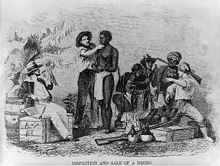
Even after slavery became a criminal offense, slave owners could get high returns. According to researcher Siddharth Kara, the profits generated worldwide by all forms of slavery in 2007 were $91.2 billion. That was second only to drug trafficking, in terms of global criminal enterprises. At the time the weighted average global sales price of a slave was estimated to be approximately $340, with a high of $1,895 for the average trafficked sex slave, and a low of $40 to $50 for debt bondage slaves in part of Asia and Africa. The weighted average annual profits generated by a slave in 2007 was $3,175, with a low of an average $950 for bonded labour and $29,210 for a trafficked sex slave. Approximately 40% of slave profits each year were generated by trafficked sex slaves, representing slightly more than 4% of the world's 29 million slaves.[69]
Identification
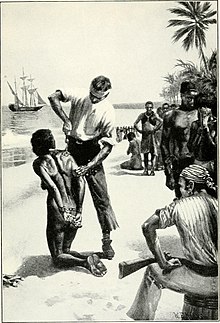
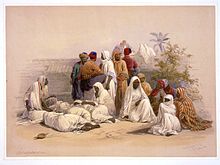
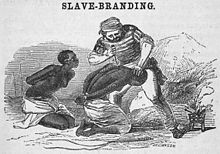
A widespread practice was branding, either to explicitly mark slaves as property or as punishment.
Legal aspects
Private versus state-owned slaves
Slaves have been owned privately by individuals but have also been under state ownership. For example, the kisaeng were women from low castes in pre modern Korea, who were owned by the state under government officials known as hojang and were required to provide entertainment to the aristocracy. In the 2020s, in North Korea, Kippumjo ("Pleasure Brigades") are made up of women selected from the general population to serve as entertainers and as concubines to the rulers of North Korea.[70][71] "Tribute labor" is compulsory labor for the state and has been used in various iterations such as corvée, mit'a and repartimiento. The internment camps of totalitarian regimes such as the Nazis and the Soviet Union placed increasing importance on the labor provided in those camps, leading to a growing tendency among historians to designate such systems as slavery.[72]
A combination of these include the encomienda where the Spanish Crown granted private individuals the right to the free labour of a specified number of natives in a given area.[73] In the "Red Rubber System" of both the Congo Free State and French ruled Ubangi-Shari,[74] labour was demanded as taxation; private companies were conceded areas within which they were allowed to use any measures to increase rubber production.[75] Convict leasing was common in the Southern United States where the state would lease prisoners for their free labour to companies.
Legal rights
Depending upon the era and the country, slaves sometimes had a limited set of legal rights. For example, in the Province of New York, people who deliberately killed slaves were punishable under a 1686 statute.[76] And, as already mentioned, certain legal rights attached to the nobi in Korea, to slaves in various African societies, and to black female slaves in the French colony of Louisiana. Giving slaves legal rights has sometimes been a matter of morality, but also sometimes a matter of self-interest. For example, in ancient Athens, protecting slaves from mistreatment simultaneously protected people who might be mistaken for slaves, and giving slaves limited property rights incentivized slaves to work harder to get more property.[77] In the southern United States prior to the extirpation of slavery in 1865, a proslavery legal treatise reported that slaves accused of crimes typically had a legal right to counsel, freedom from double jeopardy, a right to trial by jury in graver cases, and the right to grand jury indictment, but they lacked many other rights such as white adults' ability to control their own lives.[78]
History
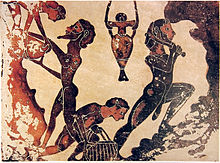
Slavery predates written records and has existed in many cultures.[3] Slavery is rare among hunter-gatherer populations because it requires economic surpluses and a substantial population density. Thus, although it has existed among unusually resource-rich hunter gatherers, such as the American Indian peoples of the salmon-rich rivers of the Pacific Northwest coast, slavery became widespread only with the invention of agriculture during the Neolithic Revolution about 11,000 years ago.[79] Slavery was practiced in almost every ancient civilization.[3] Such institutions included debt bondage, punishment for crime, the enslavement of prisoners of war, child abandonment, and the enslavement of slaves' offspring.[80]
Africa
Slavery was widespread in Africa, which pursued both internal and external slave trade.[81] In the Senegambia region, between 1300 and 1900, close to one-third of the population was enslaved. In early Islamic states of the western Sahel, including Ghana, Mali, Segou, and Songhai, about a third of the population were enslaved.[82]
In European courtly society, and European aristocracy, black African slaves and their children became visible in the late 1300s and 1400s. Starting with Frederick II, Holy Roman Emperor, black Africans were included in the retinue. In 1402 an Ethiopian embassy reached Venice. In the 1470s black Africans were painted as court attendants in wall paintings that were displayed in Mantua and Ferrara. In the 1490s black Africans were included on the emblem of the Duke of Milan.[83]

During the trans-Saharan slave trade, slaves from West Africa were transported across the Sahara desert to North Africa to be sold to Mediterranean and Middle eastern civilizations. During the Red Sea slave trade, slaves were transported from Africa across the Red Sea to the Arabian Peninsula. The Indian Ocean slave trade, sometimes known as the east African slave trade, was multi-directional. Africans were sent as slaves to the Arabian Peninsula, to Indian Ocean islands (including Madagascar), to the Indian subcontinent, and later to the Americas. These traders captured Bantu peoples (Zanj) from the interior in present-day Kenya, Mozambique and Tanzania and brought them to the coast.[85][86] There, the slaves gradually assimilated in rural areas, particularly on Unguja and Pemba islands.[87]
Some historians assert that as many as 17 million people were sold into slavery on the coast of the Indian Ocean, the Middle East, and North Africa, and approximately 5 million African slaves were bought by Muslim slave traders and taken from Africa across the Red Sea, Indian Ocean, and Sahara Desert between 1500 and 1900.[88] The captives were sold throughout the Middle East. This trade accelerated as superior ships led to more trade and greater demand for labour on plantations in the region. Eventually, tens of thousands of captives were being taken every year.[87][89][90] The Indian Ocean slave trade was multi-directional and changed over time. To meet the demand for menial labour, Bantu slaves bought by east African slave traders from southeastern Africa were sold in cumulatively large numbers over the centuries to customers in Egypt, Arabia, the Persian Gulf, India, European colonies in the Far East, the Indian Ocean islands, Ethiopia and Somalia.[91]
According to the Encyclopedia of African History, "It is estimated that by the 1890s the largest slave population of the world, about 2 million people, was concentrated in the territories of the Sokoto Caliphate. The use of slave labour was extensive, especially in agriculture."[92][93] The Anti-Slavery Society estimated there were 2 million slaves in Ethiopia in the early 1930s out of an estimated population of 8 to 16 million.[94]
Slave labour in East Africa was drawn from the Zanj, Bantu peoples that lived along the East African coast.[86][95] The Zanj were for centuries shipped as slaves by Arab traders to all the countries bordering the Indian Ocean during the Indian Ocean slave trade. The Umayyad and Abbasid caliphs recruited many Zanj slaves as soldiers and, as early as 696, there were slave revolts of the Zanj against their Arab enslavers during their slavery in the Umayyad Caliphate in Iraq. The Zanj Rebellion, a series of uprisings that took place between 869 and 883 near Basra (also known as Basara), against the slavery in the Abbasid Caliphate situated in present-day Iraq, is believed to have involved enslaved Zanj that had originally been captured from the African Great Lakes region and areas further south in East Africa.[96] It grew to involve over 500,000 slaves and free men who were imported from across the Muslim empire and claimed over "tens of thousands of lives in lower Iraq".[97]
The Zanj who were taken as slaves to the Middle East were often used in strenuous agricultural work.[98] As the plantation economy boomed and the Arabs became richer, agriculture and other manual labour work was thought to be demeaning. The resulting labour shortage led to an increased slave market.
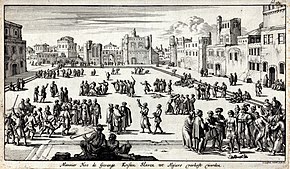
In Algiers, the capital of Algeria, captured Christians and Europeans were forced into slavery. In about 1650, there were as many as 35,000 Christian slaves in Algiers.[99] By one estimate, raids by Barbary slave traders on coastal villages and ships extending from Italy to Iceland, enslaved an estimated 1 to 1.25 million Europeans between the 16th and 19th centuries.[100][101][102] However, this estimate is the result of an extrapolation which assumes that the number of European slaves captured by Barbary pirates was constant for a 250-year period:
There are no records of how many men, women and children were enslaved, but it is possible to calculate roughly the number of fresh captives that would have been needed to keep populations steady and replace those slaves who died, escaped, were ransomed, or converted to Islam. On this basis it is thought that around 8,500 new slaves were needed annually to replenish numbers – about 850,000 captives over the century from 1580 to 1680. By extension, for the 250 years between 1530 and 1780, the figure could easily have been as high as 1,250,000.[103]
Davis' numbers have been refuted by other historians, such as David Earle, who cautions that true picture of Europeans slaves is clouded by the fact the corsairs also seized non-Christian whites from eastern Europe.[103] In addition, the number of slaves traded was hyperactive,[clarification needed] with exaggerated estimates relying on peak years to calculate averages for entire centuries, or millennia. Hence, there were wide fluctuations year-to-year, particularly in the 18th and 19th centuries, given slave imports, and also given the fact that, prior to the 1840s, there are no consistent records. Middle East expert, John Wright, cautions that modern estimates are based on back-calculations from human observation.[104] Such observations, across the late 16th and early 17th century observers, account for around 35,000 European Christian slaves held throughout this period on the Barbary Coast, across Tripoli, Tunis, but mostly in Algiers. The majority were sailors (particularly those who were English), taken with their ships, but others were fishermen and coastal villagers. However, most of these captives were people from lands close to Africa, particularly Spain and Italy.[105] This eventually led to the bombardment of Algiers by an Anglo-Dutch fleet in 1816.[106][107]

Under Omani Arabs, Zanzibar became East Africa's main slave port, with as many as 50,000 African slaves passing through every year during the 19th century.[108][109] Some historians estimate that between 11 and 18 million African slaves crossed the Red Sea, Indian Ocean, and Sahara Desert from 650 to 1900 AD.[3][failed verification][110] Eduard Rüppell described the losses of Sudanese slaves being transported on foot to Egypt: "after the Daftardar bey's 1822 campaign in the southern Nuba mountains, nearly 40,000 slaves were captured. However, through bad treatment, disease and desert travel barely 5,000 made it to Egypt."[111] W.A. Veenhoven wrote: "The German doctor, Gustav Nachtigal, an eye-witness, believed that for every slave who arrived at a market three or four died on the way ... Keltie (The Partition of Africa, London, 1920) believes that for every slave the Arabs brought to the coast at least six died on the way or during the slavers' raid. Livingstone puts the figure as high as ten to one."[112]
Systems of servitude and slavery were common in parts of Africa, as they were in much of the ancient world. In many African societies where slavery was prevalent, the slaves were not treated as chattel slaves and were given certain rights in a system similar to indentured servitude elsewhere in the world. The forms of slavery in Africa were closely related to kinship structures. In many African communities, where land could not be owned, enslavement of individuals was used as a means to increase the influence a person had and expand connections.[113] This made slaves a permanent part of a master's lineage and the children of slaves could become closely connected with the larger family ties.[114] Children of slaves born into families could be integrated into the master's kinship group and rise to prominent positions within society, even to the level of chief in some instances. However, stigma often remained attached and there could be strict separations between slave members of a kinship group and those related to the master.[113] Slavery was practiced in many different forms: debt slavery, enslavement of war captives, military slavery, and criminal slavery were all practiced in various parts of Africa.[115] Slavery for domestic and court purposes was widespread throughout Africa.

When the Atlantic slave trade began, many of the local slave systems began supplying captives for chattel slave markets outside Africa. Although the Atlantic slave trade was not the only slave trade from Africa, it was the largest in volume and intensity. As Elikia M'bokolo wrote in Le Monde diplomatique:
The African continent was bled of its human resources via all possible routes. Across the Sahara, through the Red Sea, from the Indian Ocean ports and across the Atlantic. At least ten centuries of slavery for the benefit of the Muslim countries (from the ninth to the nineteenth).... Four million enslaved people exported via the Red Sea, another four million through the Swahili ports of the Indian Ocean, perhaps as many as nine million along the trans-Saharan caravan route, and eleven to twenty million (depending on the author) across the Atlantic Ocean.[116]
The trans-Atlantic slave trade peaked in the late 18th century, when the largest number of slaves were captured on raiding expeditions into the interior of West Africa.
These expeditions were typically carried out by African kingdoms, such as the Oyo Empire (Yoruba), the Ashanti Empire,[117] the kingdom of Dahomey,[118] and the Aro Confederacy.[119] It is estimated that about 15 percent of slaves died during the voyage, with mortality rates considerably higher in Africa itself in the process of capturing and transporting indigenous peoples to the ships.[120][121]
Americas
Slavery in Mexico can be traced back to the Aztecs.[122] Other Amerindians, such as the Inca of the Andes, the Tupinambá of Brazil, the Creek of Georgia, and the Comanche of Texas, also practiced slavery.[3]
Slavery in Canada was practiced by First Nations and by European settlers.[123] Slave-owning people of what became Canada were, for example, the fishing societies, such as the Yurok, that lived along the Pacific coast from Alaska to California,[124] on what is sometimes described as the Pacific or Northern Northwest Coast. Some of the indigenous peoples of the Pacific Northwest Coast, such as the Haida and Tlingit, were traditionally known as fierce warriors and slave-traders, raiding as far as California. Slavery was hereditary, the slaves being prisoners of war and their descendants were slaves.[125] Some nations in British Columbia continued to segregate and ostracize the descendants of slaves as late as the 1970s.[126]
Slavery in America remains a contentious issue and played a major role in the history and evolution of some countries, triggering a revolution, a civil war, and numerous rebellions.
The countries that controlled most of the transatlantic slave market in terms of number of slaves shipped were the UK, Portugal and France.
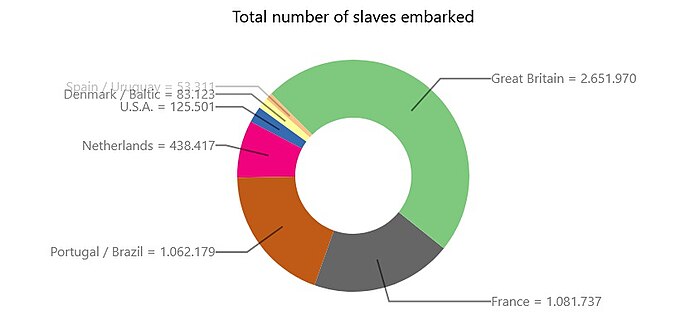
In order to establish itself as an American empire, Spain had to fight against the relatively powerful civilizations of the New World. The Spanish conquest of the indigenous peoples in the Americas included using the Natives as forced labour. The Spanish colonies were the first Europeans to use African slaves in the New World on islands such as Cuba and Hispaniola.[127] It was argued by some contemporary writers to be intrinsically immoral.[128][129][130] Bartolomé de las Casas, a 16th-century Dominican friar and Spanish historian, participated in campaigns in Cuba (at Bayamo and Camagüey) and was present at the massacre of Hatuey; his observation of that massacre led him to fight for a social movement away from the use of natives as slaves. Also, the alarming decline in the native population had spurred the first royal laws protecting the native population. The first African slaves arrived in Hispaniola in 1501.[131] This era saw a growth in race-based slavery.[132] England played a prominent role in the Atlantic slave trade. The "slave triangle" was pioneered by Francis Drake and his associates, though English slave-trading would not take off until the mid-17th century.
Many whites who arrived in North America during the 17th and 18th centuries came under contract as indentured servants.[133] The transformation from indentured servitude to slavery was a gradual process in Virginia. The earliest legal documentation of such a shift was in 1640 where a black man, John Punch, was sentenced to lifetime slavery, forcing him to serve his master, Hugh Gwyn, for the remainder of his life, for attempting to run away. This case was significant because it established the disparity between his sentence as a black man and that of the two white indentured servants who escaped with him (one described as Dutch and one as a Scotchman). It is the first documented case of a black man sentenced to lifetime servitude and is considered one of the first legal cases to make a racial distinction between black and white indentured servants.[134][135]
After 1640, planters started to ignore the expiration of indentured contracts and keep their servants as slaves for life. This was demonstrated by the 1655 case Johnson v. Parker, where the court ruled that a black man, Anthony Johnson of Virginia, was granted ownership of another black man, John Casor, as the result of a civil case.[136] This was the first instance of a judicial determination in the Thirteen Colonies holding that a person who had committed no crime could be held in servitude for life.[137][138]
Spanish colonial America
In 1519, Hernán Cortés brought the first modern slave to the area.[139] In the mid-16th century, the Spanish New Laws, prohibited slavery of the indigenous people, including the Aztecs. A labour shortage resulted. This led to the African slaves being imported, as they were not susceptible to smallpox. In exchange, many Africans were afforded the opportunity to buy their freedom, while eventually others were granted their freedom by their masters.[139] In Jamaica, the Spanish enslaved many of the Taino; some escaped, but most died from European diseases and overwork. The Spaniards also introduced the first African slaves.[140]
Spain practically did not trade in slaves until 1810 after the rebellions and independence of its American territories or viceroyalties. After the Napoleonic invasions, Spain had lost its industry and its American territories, except in Cuba and Puerto Rico, where the African slave trade to Cuba began on a massive scale from 1810 onwards. It was started by French planters exiled from the French lost colony Saint Domingue (Haiti) who settled in the eastern part of Cuba.
In 1789, the Spanish Crown led an effort to reform slavery, as the demand for slave labour in Cuba was growing. The Crown issued a decree, Código Negro Español (Spanish Black Code), that specified food and clothing provisions, put limits on the number of work hours, limited punishments, required religious instruction, and protected marriages, forbidding the sale of young children away from their mothers. The British made other changes to the institution of slavery in Cuba. However, planters often flouted the laws and protested against them, considering them a threat to their authority and an intrusion into their personal lives.[141]
English and Dutch Caribbean
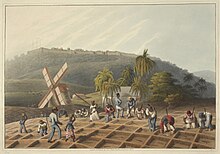
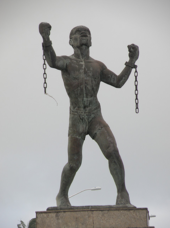
In the early 17th century, the majority of the labour in Barbados was provided by European indentured servants, mainly English, Irish and Scottish, with African and native American slaves providing little of the workforce. The introduction of sugar cane in 1640 completely transformed society and the economy. Barbados eventually had one of the world's largest sugar industries.[142] The workable sugar plantation required a large investment and a great deal of heavy labour. At first, Dutch traders supplied the equipment, financing, and African slaves, in addition to transporting most of the sugar to Europe. In 1644, the population of Barbados was estimated at 30,000, of which about 800 were of African descent, with the remainder mainly of English descent. By 1700, there were 15,000 free whites and 50,000 enslaved Africans. In Jamaica, although the African slave population in the 1670s and 1680s never exceeded 10,000, by 1800 it had increased to over 300,000. The increased implementation of slave codes or black codes, which created differential treatment between Africans and the white workers and ruling planter class. In response to these codes, several slave rebellions were attempted or planned during this time, but none succeeded.
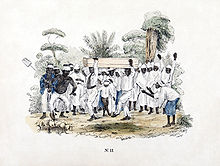
The planters of the Dutch colony of Suriname relied heavily on African slaves to cultivate, harvest and process the commodity crops of coffee, cocoa, sugar cane and cotton plantations.[143] The Netherlands abolished slavery in Suriname in 1863.
Many slaves escaped the plantations. With the help of the native South Americans living in the adjoining rain forests, these runaway slaves established a new and unique culture in the interior that was highly successful in its own right. They were known collectively in English as Maroons, in French as Nèg'Marrons (literally meaning "brown negroes", that is "pale-skinned negroes"), and in Dutch as Marrons. The Maroons gradually developed several independent tribes through a process of ethnogenesis, as they were made up of slaves from different African ethnicities. These tribes include the Saramaka, Paramaka, Ndyuka or Aukan, Kwinti, Aluku or Boni, and Matawai. The Maroons often raided plantations to recruit new members from the slaves and capture women, as well as to acquire weapons, food and supplies. They sometimes killed planters and their families in the raids.[144] The colonists also mounted armed campaigns against the Maroons, who generally escaped through the rain forest, which they knew much better than did the colonists. To end hostilities, in the 18th century the European colonial authorities signed several peace treaties with different tribes. They granted the Maroons sovereign status and trade rights in their inland territories, giving them autonomy.
Brazil
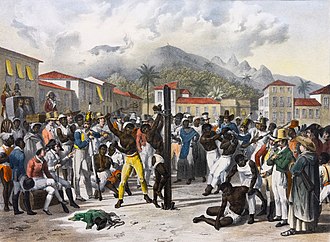
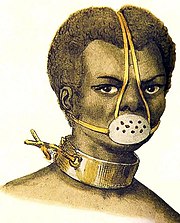
Slavery in Brazil began long before the first Portuguese settlement was established in 1532, as members of one tribe would enslave captured members of another.[145]
Later, Portuguese colonists were heavily dependent on indigenous labour during the initial phases of settlement to maintain the subsistence economy, and natives were often captured by expeditions called bandeiras. The importation of African slaves began midway through the 16th century, but the enslavement of indigenous peoples continued well into the 17th and 18th centuries.
During the Atlantic slave trade era, Brazil imported more African slaves than any other country. Nearly 5 million slaves were brought from Africa to Brazil during the period from 1501 to 1866.[146] Until the early 1850s, most African slaves who arrived on Brazilian shores were forced to embark at West Central African ports, especially in Luanda (in present-day Angola). Today, with the exception of Nigeria, the country with the largest population of people of African descent is Brazil.[147]
Slave labour was the driving force behind the growth of the sugar economy in Brazil, and sugar was the primary export of the colony from 1600 to 1650. Gold and diamond deposits were discovered in Brazil in 1690, which sparked an increase in the importation of African slaves to power this newly profitable market. Transportation systems were developed for the mining infrastructure, and population boomed from immigrants seeking to take part in gold and diamond mining. Demand for African slaves did not wane after the decline of the mining industry in the second half of the 18th century. Cattle ranching and foodstuff production proliferated after the population growth, both of which relied heavily on slave labour. 1.7 million slaves were imported to Brazil from Africa from 1700 to 1800, and the rise of coffee in the 1830s further enticed expansion of the slave trade.
Brazil was the last country in the Western world to abolish slavery. Forty percent of the total number of slaves brought to the Americas were sent to Brazil. For reference, the United States received 10 percent. Despite being abolished, there are still people working in slavery-like conditions in Brazil in the 21st century.
Haiti
Slavery in Haiti started with the arrival of Christopher Columbus on the island in 1492. The practice was devastating to the native population.[148] Following the indigenous Taíno's near decimation from forced labour, disease and war, the Spanish, under advisement of the Catholic priest Bartolomé de las Casas, and with the blessing of the Catholic church, who also wished to protect the indigenous people, began engaging in earnest in the use of African slaves.[clarification needed] During the French colonial period beginning in 1625, the economy of Haiti (then known as Saint-Domingue) was based on slavery, and the practice there was regarded as the most brutal in the world.


Following the Treaty of Ryswick of 1697, Hispaniola was divided between France and Spain. France received the western third and subsequently named it Saint-Domingue. To develop it into sugarcane plantations, the French imported thousands of slaves from Africa. Sugar was a lucrative commodity crop throughout the 18th century. By 1789, approximately 40,000 white colonists lived in Saint-Domingue. The whites were vastly outnumbered by the tens of thousands of African slaves they had imported to work on their plantations, which were primarily devoted to the production of sugarcane. In the north of the island, slaves were able to retain many ties to African cultures, religion and language; these ties were continually being renewed by newly imported Africans. Blacks outnumbered whites by about ten to one.
The French-enacted Code Noir ("Black Code"), prepared by Jean-Baptiste Colbert and ratified by Louis XIV, had established rules on slave treatment and permissible freedoms. Saint-Domingue has been described as one of the most brutally efficient slave colonies; one-third of newly imported Africans died within a few years.[149] Many slaves died from diseases such as smallpox and typhoid fever.[150] They had birth rates around 3 percent, and there is evidence that some women aborted fetuses, or committed infanticide, rather than allow their children to live within the bonds of slavery.[151][152]
As in its Louisiana colony, the French colonial government allowed some rights to free people of color: the mixed-race descendants of white male colonists and black female slaves (and later, mixed-race women). Over time, many were released from slavery. They established a separate social class. White French Creole fathers frequently sent their mixed-race sons to France for their education. Some men of color were admitted into the military. More of the free people of color lived in the south of the island, near Port-au-Prince, and many intermarried within their community. They frequently worked as artisans and tradesmen, and began to own some property. Some became slave holders. The free people of color petitioned the colonial government to expand their rights.
Slaves that made it to Haiti from the trans-Atlantic journey and slaves born in Haiti were first documented in Haiti's archives and transferred to France's Ministry of Defense and the Ministry of Foreign Affairs. As of 2015[update], these records are in The National Archives of France. According to the 1788 Census, Haiti's population consisted of nearly 40,000 whites, 30,000 free coloureds and 450,000 slaves.[153]
The Haitian Revolution of 1804, the only successful slave revolt in human history, precipitated the end of slavery in all French colonies, which came in 1848.
United States
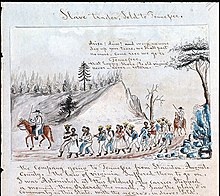
Slavery in the United States was the legal institution of human chattel enslavement, primarily of Africans and African Americans, that existed in the United States of America in the 18th and 19th centuries, after it gained independence from the British and before the end of the American Civil War. Slavery had been practiced in British America from early colonial days and was legal in all Thirteen Colonies, at the time of the Declaration of Independence in 1776. By the time of the American Revolution, the status of slave had been institutionalized as a racial caste associated with African ancestry.[154] The United States became polarized over the issue of slavery, represented by the slave and free states divided by the Mason–Dixon line, which separated free Pennsylvania from slave Maryland and Delaware.
Congress, during the Jefferson administration, prohibited the importation of slaves, effective 1808, although smuggling (illegal importing) was not unusual.[155] Domestic slave trading, however, continued at a rapid pace, driven by labour demands from the development of cotton plantations in the Deep South. Those states attempted to extend slavery into the new western territories to keep their share of political power in the nation. Such laws proposed to Congress to continue the spread of slavery into newly ratified states include the Kansas-Nebraska Act.
The treatment of slaves in the United States varied widely depending on conditions, times, and places. The power relationships of slavery corrupted many whites who had authority over slaves, with children showing their own cruelty. Masters and overseers resorted to physical punishments to impose their wills. Slaves were punished by whipping, shackling, hanging, beating, burning, mutilation, branding and imprisonment. Punishment was most often meted out in response to disobedience or perceived infractions, but sometimes abuse was carried out to re-assert the dominance of the master or overseer of the slave.[156] Treatment was usually harsher on large plantations, which were often managed by overseers and owned by absentee slaveholders.
William Wells Brown, who escaped to freedom, reported that on one plantation, slave men were required to pick 80 pounds (36 kg) of cotton per day, while women were required to pick 70 pounds (32 kg) per day; if any slave failed in their quota, they were subject to whip lashes for each pound they were short. The whipping post stood next to the cotton scales.[157] A New York man who attended a slave auction in the mid-19th century reported that at least three-quarters of the male slaves he saw at sale had scars on their backs from whipping.[158] By contrast, small slave-owning families had closer relationships between the owners and slaves; this sometimes resulted in a more humane environment but was not a given.[156]
More than one million slaves were sold from the Upper South, which had a surplus of labour, and taken to the Deep South in a forced migration, splitting up many families. New communities of African American culture were developed in the Deep South, and the total slave population in the South eventually reached 4 million before liberation.[159][160] In the 19th century, proponents of slavery often defended the institution as a "necessary evil". White people of that time feared that emancipation of black slaves would have more harmful social and economic consequences than the continuation of slavery. The French writer and traveler Alexis de Tocqueville, in Democracy in America (1835), expressed opposition to slavery while observing its effects on American society. He felt that a multiracial society without slavery was untenable, as he believed that prejudice against black people increased as they were granted more rights. Others, like James Henry Hammond argued that slavery was a "positive good" stating: "Such a class you must have, or you would not have that other class which leads progress, civilization, and refinement."
The Southern state governments wanted to keep a balance between the number of slave and free states to maintain a political balance of power in Congress. The new territories acquired from Britain, France, and Mexico were the subject of major political compromises. By 1850, the newly rich cotton-growing South was threatening to secede from the Union, and tensions continued to rise. Many white Southern Christians, including church ministers, attempted to justify their support for slavery as modified by Christian paternalism.[161] The largest denominations, the Baptist, Methodist, and Presbyterian churches, split over the slavery issue into regional organizations of the North and South.
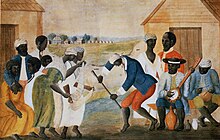
When Abraham Lincoln won the 1860 election on a platform of halting the expansion of slavery, according to the 1860 U.S. census, roughly 400,000 individuals, representing 8% of all U.S. families, owned nearly 4,000,000 slaves.[162] One-third of Southern families owned slaves.[163] The South was heavily invested in slavery. As such, upon Lincoln's election, seven states broke away to form the Confederate States of America. The first six states to secede held the greatest number of slaves in the South. Shortly after, over the issue of slavery, the United States erupted into an all-out Civil War, with slavery legally ceasing as an institution following the war in December 1865.
In 1865, the United States ratified the 13th Amendment to the United States Constitution, which banned slavery and involuntary servitude "except as punishment for a crime whereof the party shall have been duly convicted," providing a legal basis for forced labor to continue in the country. This led to the system of convict leasing, which affected primarily African Americans. The Prison Policy Initiative, an American criminal justice think tank, cites the 2020 US prison population as 2.3 million, and nearly all able-bodied inmates work in some fashion. In Texas, Georgia, Alabama and Arkansas, prisoners are not paid at all for their work. In other states, prisoners are paid between $0.12 and $1.15 per hour. Federal Prison Industries paid inmates an average of $0.90 per hour in 2017. Inmates who refuse to work may be indefinitely remanded into solitary confinement or have family visitation revoked. From 2010 to 2015 and again in 2016 and in 2018, some prisoners in the US refused to work, protesting for better pay, better conditions, and for the end of forced labor. Strike leaders were punished with indefinite solitary confinement. Forced prison labor occurs in both government-run prisons and private prisons. CoreCivic and GEO Group constitute half the market share of private prisons, and they made a combined revenue of $3.5 billion in 2015. The value of all labor by inmates in the United States is estimated to be in the billions. In California, 2,500 incarcerated workers fought wildfires for only $1 per hour through the CDCR's Conservation Camp Program, which saves the state as much as $100 million a year.[164]
Asia-Pacific
East Asia
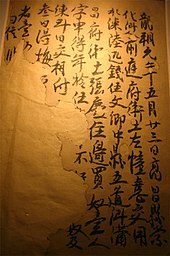
Slavery existed in ancient China as early as the Shang dynasty.[165] Slavery was employed largely by governments as a means of maintaining a public labour force.[166][167] Until the Han dynasty, slaves were sometimes discriminated against but their legal status was guaranteed. As can be seen from the some historical records as “Duansheng, Marquis of Shouxiang, had his territory confiscated because he killed a female slave”(Han dynasty records in DongGuan), “Wang Mang's son Wang Huo murdered a slave, Wang Mang severely criticized him and forced him to commit suicide”(Book of Han: Biography of Wang Mang), Murder against slaves was as taboo as murder against free people, and perpetrators were always severely punished. Han dynasty can be said to be very distinctive compared to other countries of the same period(In most cases, lords were free to kill their slaves) in terms of slaves human rights.
After the Southern and Northern Dynasties, Due to years of poor harvests, the influx of foreign tribes, and the resulting wars, The number of slaves exploded. They became a class and were called "jianmin (Chinese: 贱民)", The word literally means "inferior person". As stated in The commentary of Tang Code: “Slaves and inferior people are legally equivalent to livestock products”, They always had a low social status, and even if they were deliberately murdered, the perpetrators received only a year in prison, and were punished even when they reported the crimes of their lords.[168] However, in the Later period of the dynasty, perhaps because the increase in the number of slaves slowed down again, the penalties for crimes against them became harsh again. For example, the famous contemporary female poet Yu Xuanji, she was publicly executed for murdering her own slave.
Many Han Chinese were enslaved in the process of the Mongol invasion of China proper.[169] According to Japanese historians Sugiyama Masaaki (杉山正明) and Funada Yoshiyuki (舩田善之), Mongolian slaves were owned by Han Chinese during the Yuan dynasty.[170][171] Slavery has taken various forms throughout China's history. It was reportedly abolished as a legally recognized institution, including in a 1909 law[172][173] fully enacted in 1910,[174] although the practice continued until at least 1949.[169] Tang Chinese soldiers and pirates enslaved Koreans, Turks, Persians, Indonesians, and people from Inner Mongolia, central Asia, and northern India.[175][176] The greatest source of slaves came from southern tribes, including Thais and aboriginals from the southern provinces of Fujian, Guangdong, Guangxi, and Guizhou. Malays, Khmers, Indians, and "black skinned" peoples (who were either Austronesian Negritos of Southeast Asia and the Pacific Islands, or Africans, or both) were also purchased as slaves in the Tang dynasty.[177]
In the 17th century Qing dynasty, there was a hereditarily servile people called Booi Aha (Manchu: booi niyalma; Chinese transliteration: 包衣阿哈), which is a Manchu word literally translated as "household person" and sometimes rendered as "nucai." The Manchu was establishing close personal and paternalist relationship between masters and their slaves, as Nurhachi said, "The Master should love the slaves and eat the same food as him".[178] However, booi aha "did not correspond exactly to the Chinese category of "bond-servant slave" (Chinese:奴僕); instead, it was a relationship of personal dependency on a master which in theory guaranteed close personal relationships and equal treatment, even though many western scholars would directly translate "booi" as "bond-servant" (some of the "booi" even had their own servant).[169] Chinese Muslim (Tungans) Sufis who were charged with practicing xiejiao (heterodox religion), were punished by exile to Xinjiang and being sold as a slave to other Muslims, such as the Sufi begs.[179] Han Chinese who committed crimes such as those dealing with opium became slaves to the begs, this practice was administered by Qing law.[180] Most Chinese in Altishahr were exile slaves to Turkestani Begs.[181] While free Chinese merchants generally did not engage in relationships with East Turkestani women, some of the Chinese slaves belonging to begs, along with Green Standard soldiers, Bannermen, and Manchus, engaged in affairs with the East Turkestani women that were serious in nature.[182]
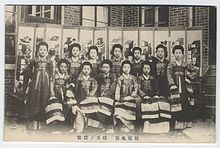
Slavery in Korea existed since before the Three Kingdoms of Korea period, in the first century BCE.[183] Slavery has been described as "very important in medieval Korea, probably more important than in any other East Asian country, but by the 16th century, population growth was making [it] unnecessary".[184] Slavery went into decline around the 10th century but came back in the late Goryeo period when Korea also experienced multiple slave rebellions.[183] In the Joseon period of Korea, members of the slave class were known as nobi. The nobi were socially indistinct from freemen (i.e., the middle and common classes) other than the ruling yangban class, and some possessed property rights, and legal and civil rights. Hence, some scholars argue that it is inappropriate to call them "slaves",[185] while some scholars describe them as serfs.[186][187] The nobi population could fluctuate up to about one-third of the total, but on average the nobi made up about 10% of the total population.[183] In 1801, the majority of government nobi were emancipated,[188] and by 1858, the nobi population stood at about 1.5 percent of the Korean population.[189] During the Joseon period, the nobi population could fluctuate up to about one-third of the population, but on average the nobi made up about 10% of the total population.[183] The nobi system declined beginning in the 18th century.[190] Since the outset of the Joseon dynasty and especially beginning in the 17th century, there was harsh criticism among prominent thinkers in Korea about the nobi system. Even within the Joseon government, there were indications of a shift in attitude toward the nobi.[191] King Yeongjo implemented a policy of gradual emancipation in 1775,[184] and he and his successor King Jeongjo made many proposals and developments that lessened the burden on nobi, which led to the emancipation of the vast majority of government nobi in 1801.[191] In addition, population growth,[184] numerous escaped slaves,[183] growing commercialization of agriculture, and the rise of the independent small farmer class contributed to the decline in the number of nobi to about 1.5% of the total population by 1858.[189] The hereditary nobi system was officially abolished around 1886–87,[183][189] and the rest of the nobi system was abolished with the Gabo Reform of 1894.[183][192] However, slavery did not completely disappear in Korea until 1930, during Imperial Japanese rule. During the Imperial Japanese occupation of Korea around World War II, some Koreans were used in forced labour by the Imperial Japanese, in conditions which have been compared to slavery.[183][193] These included women forced into sexual slavery by the Imperial Japanese Army before and during World War II, known as "comfort women".[183][193]
After the Portuguese first made contact with Japan in 1543, slave trade developed in which Portuguese purchased Japanese as slaves in Japan and sold them to various locations overseas, including Portugal, throughout the 16th and 17th centuries.[194][195] Many documents mention the slave trade along with protests against the enslavement of Japanese. Japanese slaves are believed to be the first of their nation to end up in Europe, and the Portuguese purchased numbers of Japanese slave girls to bring to Portugal for sexual purposes, as noted by the Church[196] in 1555. Japanese slave women were even sold as concubines to Asian lascar and African crew members, along with their European counterparts serving on Portuguese ships trading in Japan, mentioned by Luis Cerqueira, a Portuguese Jesuit, in a 1598 document.[197] Japanese slaves were brought by the Portuguese to Macau, where they were enslaved to Portuguese or became slaves to other slaves.[198][199] Some Korean slaves were bought by the Portuguese and brought back to Portugal from Japan, where they had been among the tens of thousands of Korean prisoners of war transported to Japan during the Japanese invasions of Korea (1592–98).[200][201] Historians pointed out that at the same time Hideyoshi expressed his indignation and outrage at the Portuguese trade in Japanese slaves, he was engaging in a mass slave trade of Korean prisoners of war in Japan.[202][203] Fillippo Sassetti saw some Chinese and Japanese slaves in Lisbon among the large slave community in 1578, although most of the slaves were black.[204][205][206][207][208]
The Portuguese also valued Oriental slaves more than the black Africans and the Moors for their rarity. Chinese slaves were more expensive than Moors and blacks and showed off the high status of the owner.[209] The Portuguese attributed qualities like intelligence and industriousness to Chinese, Japanese and Indian slaves.[210][206] King Sebastian of Portugal feared rampant slavery was having a negative effect on Catholic proselytization, so he commanded that it be banned in 1571.[211] Hideyoshi was so disgusted that his own Japanese people were being sold en masse into slavery on Kyushu, that he wrote a letter to Jesuit Vice-Provincial Gaspar Coelho on July 24, 1587, to demand the Portuguese, Siamese (Thai), and Cambodians stop purchasing and enslaving Japanese and return Japanese slaves who ended up as far as India.[212][213][214] Hideyoshi blamed the Portuguese and Jesuits for this slave trade and banned Christian proselytizing as a result.[215][self-published source][216] In 1595, a law was passed by Portugal banning the selling and buying of Chinese and Japanese slaves.[217]
South Asia
Slavery in India was widespread by the 6th century BC, and perhaps even as far back as the Vedic period.[218] Slavery intensified during the Muslim domination of northern India after the 11th-century.[219] Slavery existed in Portuguese India after the 16th century. The Dutch, too, largely dealt in Abyssian slaves, known in India as Habshis or Sheedes.[220] Arakan/Bengal, Malabar, and Coromandel remained the largest sources of forced labour until the 1660s.
Between 1626 and 1662, the Dutch exported on an average 150–400 slaves annually from the Arakan-Bengal coast. During the first 30 years of Batavia's existence, Indian and Arakanese slaves provided the main labour force of the Dutch East India Company, Asian headquarters. An increase in Coromandel slaves occurred during a famine following the revolt of the Nayaka Indian rulers of South India (Tanjavur, Senji, and Madurai) against Bijapur overlordship (1645) and the subsequent devastation of the Tanjavur countryside by the Bijapur army. Reportedly, more than 150,000 people were taken by the invading Deccani Muslim armies to Bijapur and Golconda. In 1646, 2,118 slaves were exported to Batavia, the overwhelming majority from southern Coromandel. Some slaves were also acquired further south at Tondi, Adirampatnam, and Kayalpatnam. Another increase in slaving took place between 1659 and 1661 from Tanjavur as a result of a series of successive Bijapuri raids. At Nagapatnam, Pulicat, and elsewhere, the company purchased 8,000–10,000 slaves, the bulk of whom were sent to Ceylon, while a small portion were exported to Batavia and Malacca. Finally, following a long drought in Madurai and southern Coromandel, in 1673, which intensified the prolonged Madurai-Maratha struggle over Tanjavur and punitive fiscal practices, thousands of people from Tanjavur, mostly children, were sold into slavery and exported by Asian traders from Nagapattinam to Aceh, Johor, and other slave markets.
In September 1687, 665 slaves were exported by the English from Fort St. George, Madras. And, in 1694–96, when warfare once more ravaged South India, a total of 3,859 slaves were imported from Coromandel by private individuals into Ceylon.[221][222][223][224] The volume of the total Dutch Indian Ocean slave trade has been estimated to be about 15–30% of the Atlantic slave trade, slightly smaller than the trans-Saharan slave trade, and one-and-a-half to three times the size of the Swahili and Red Sea coast and the Dutch West India Company slave trades.[225]
According to Sir Henry Bartle Frere (who sat on the Viceroy's Council), there were an estimated 8 or 9 million slaves in India in 1841. About 15% of the population of Malabar were slaves. Slavery was legally abolished in the possessions of the East India Company by the Indian Slavery Act, 1843.[3]
South East Asia
The hill tribe people in Indochina were "hunted incessantly and carried off as slaves by the Siamese (Thai), the Anamites (Vietnamese), and the Cambodians".[226] A Siamese military campaign in Laos in 1876 was described by a British observer as having been "transformed into slave-hunting raids on a large scale".[226] The census, taken in 1879, showed that 6% of the population in the Malay sultanate of Perak were slaves.[227] Enslaved people made up about two-thirds of the population in part of North Borneo in the 1880s.[227]
Oceania
Slaves (he mōkai) had a recognised social role in traditional Māori society in New Zealand.[228]
Blackbirding occurred on islands in the Pacific Ocean and Australia, especially in the 19th century.
Europe
Ancient Greece and Rome

Records of slavery in Ancient Greece begin with Mycenaean Greece. Classical Athens had the largest slave population, with as many as 80,000 in the 6th and 5th centuries BC.[229] As the Roman Republic expanded outward, entire populations were enslaved, across Europe and the Mediterranean. Slaves were used for labour, as well as for amusement (e.g., gladiators and sex slaves). This oppression by an elite minority eventually led to slave revolts (see Roman Servile Wars); the Third Servile War was led by Spartacus.
By the late Republican era, slavery had become an economic pillar of Roman wealth, as well as Roman society.[230] It is estimated that 25% or more of the population of Ancient Rome was enslaved, although the actual percentage is debated by scholars and varied from region to region.[231][232] Slaves represented 15–25% of Italy's population,[233] mostly war captives,[233] especially from Gaul[234] and Epirus. Estimates of the number of slaves in the Roman Empire suggest that the majority were scattered throughout the provinces outside of Italy.[233] Generally, slaves in Italy were indigenous Italians.[235] Foreigners (including both slaves and freedmen) born outside of Italy were estimated to have peaked at 5% of the total in the capital, where their number was largest. Those from outside of Europe were predominantly of Greek descent. Jewish slaves never fully assimilated into Roman society, remaining an identifiable minority. These slaves (especially the foreigners) had higher death rates and lower birth rates than natives and were sometimes subjected to mass expulsions.[236] The average recorded age at death for the slaves in Rome was seventeen and a half years (17.2 for males; 17.9 for females).[237]
Medieval and early modern Europe
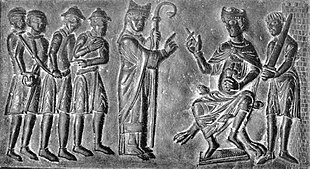
Slavery in early medieval Europe was so common that the Catholic Church repeatedly prohibited it, or at least the export of Christian slaves to non-Christian lands, as for example at the Council of Koblenz (922), the Council of London (1102) (which aimed mainly at the sale of English slaves to Ireland)[238] and the Council of Armagh (1171). Serfdom, on the contrary, was widely accepted. In 1452, Pope Nicholas V issued the papal bull Dum Diversas, granting the kings of Spain and Portugal the right to reduce any "Saracens (Muslims), pagans and any other unbelievers" to perpetual slavery, legitimizing the slave trade as a result of war.[239] The approval of slavery under these conditions was reaffirmed and extended in his Romanus Pontifex bull of 1455. Large-scale trading in slaves was mainly confined to the South and East of early medieval Europe: the Byzantine Empire and the Muslim world were the destinations, while pagan Central and Eastern Europe (along with the Caucasus and Tartary) were important sources. Viking, Arab, Greek, and Radhanite Jewish merchants were all involved in the slave trade during the Early Middle Ages.[240][241][242] The trade in European slaves reached a peak in the 10th century following the Zanj Rebellion, which dampened the use of African slaves in the Arab world.[243][244]
In Britain, slavery continued to be practiced following the fall of Rome, while sections of Æthelstan's and Hywel the Good's laws dealt with slaves in medieval England and medieval Wales respectively.[245][246] The trade particularly picked up after the Viking invasions, with major markets at Chester[247] and Bristol[248] supplied by Danish, Mercian, and Welsh raiding of one another's borderlands. At the time of the Domesday Book, nearly 10% of the English population were slaves.[249] William the Conqueror introduced a law preventing the sale of slaves overseas.[250] According to historian John Gillingham, by 1200 slavery in the British Isles was non-existent.[251] Slavery had never been authorized by statute within England and Wales, and in 1772, in the case Somerset v Stewart, Lord Mansfield declared that it was also unsupported within England by the common law. The slave trade was abolished by the Slave Trade Act 1807, although slavery remained legal in possessions outside Europe until the passage of the Slavery Abolition Act 1833 and the Indian Slavery Act, 1843.[252] However, when England began to have colonies in the Americas, and particularly from the 1640s, African slaves began to make their appearance in England and remained a presence until the eighteenth century. In Scotland, slaves continued to be sold as chattels until late in the eighteenth century (on the second May 1722, an advertisement appeared in the Edinburgh Evening Courant, announcing that a stolen slave had been found, who would be sold to pay expenses, unless claimed within two weeks).[253] For nearly two hundred years in the history of coal mining in Scotland, miners were bonded to their "maisters" by a 1606 Act "Anent Coalyers and Salters". The Colliers and Salters (Scotland) Act 1775 stated that "many colliers and salters are in a state of slavery and bondage" and announced emancipation; those starting work after July 1, 1775, would not become slaves, while those already in a state of slavery could, after 7 or 10 years depending on their age, apply for a decree of the Sheriff's Court granting their freedom. Few could afford this, until a further law in 1799 established their freedom and made this slavery and bondage illegal.[253][254]
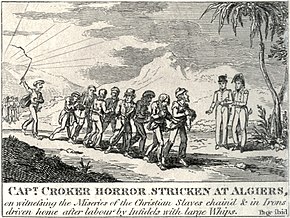
The Byzantine-Ottoman wars and the Ottoman wars in Europe brought large numbers of slaves into the Islamic world.[255] To staff its bureaucracy, the Ottoman Empire established a janissary system which seized hundreds of thousands of Christian boys through the devşirme system. They were well cared for but were legally slaves owned by the government and were not allowed to marry. They were never bought or sold. The empire gave them significant administrative and military roles. The system began about 1365; there were 135,000 janissaries in 1826, when the system ended.[256] After the Battle of Lepanto, 12,000 Christian galley slaves were recaptured and freed from the Ottoman fleet.[257] Eastern Europe suffered a series of Tatar invasions, the goal of which was to loot and capture slaves for selling them to Ottomans as jasyr.[258] Seventy-five Crimean Tatar raids were recorded into Poland–Lithuania between 1474 and 1569.[259]
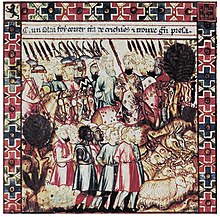
Medieval Spain and Portugal were the scene of almost constant Muslim invasion of the predominantly Christian area. Periodic raiding expeditions were sent from Al-Andalus to ravage the Iberian Christian kingdoms, bringing back booty and slaves. In a raid against Lisbon in 1189, for example, the Almohad caliph Yaqub al-Mansur took 3,000 female and child captives, while his governor of Córdoba, in a subsequent attack upon Silves, Portugal, in 1191, took 3,000 Christian slaves.[260] From the 11th to the 19th century, North African Barbary Pirates engaged in raids on European coastal towns to capture Christian slaves to sell at slave markets in places such as Algeria and Morocco.[261]
The maritime town of Lagos was the first slave market created in Portugal (one of the earliest colonizers of the Americas) for the sale of imported African slaves – the Mercado de Escravos, opened in 1444.[262][263] In 1441, the first slaves were brought to Portugal from northern Mauritania.[263] By 1552, black African slaves made up 10% of the population of Lisbon.[264][265] In the second half of the 16th century, the Crown gave up the monopoly on slave trade, and the focus of European trade in African slaves shifted from import to Europe to slave transports directly to tropical colonies in the Americas – especially Brazil.[263] In the 15th century one-third of the slaves were resold to the African market in exchange of gold.[266]
Until the late 18th century, the Crimean Khanate (a Muslim Tatar state) maintained a massive slave trade with the Ottoman Empire and the Middle East.[258] The slaves were captured in southern Russia, Poland-Lithuania, Moldavia, Wallachia, and Circassia by Tatar horsemen[267] and sold in the Crimean port of Kaffa.[268] About 2 million mostly Christian slaves were exported over the 16th and 17th centuries[269] until the Crimean Khanate was destroyed by the Russian Empire in 1783.[270]

In Kievan Rus and Muscovy, slaves were usually classified as kholops. According to David P. Forsythe, "In 1649 up to three-quarters of Muscovy's peasants, or 13 to 14 million people, were serfs whose material lives were barely distinguishable from slaves. Perhaps another 1.5 million were formally enslaved, with Russian slaves serving Russian masters."[272] Slavery remained a major institution in Russia until 1723, when Peter the Great converted the household slaves into house serfs. Russian agricultural slaves were formally converted into serfs earlier in 1679.[273] Slavery in Poland was forbidden in the 15th century; in Lithuania, slavery was formally abolished in 1588; they were replaced by the second serfdom.
In Scandinavia, thralldom was abolished in the mid-14th century.[274]
World War II
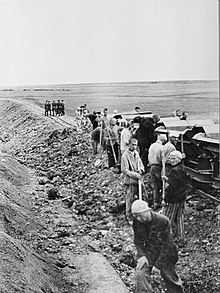
During the Second World War, Nazi Germany effectively enslaved about 12 million people, both those considered undesirable and citizens of conquered countries, with the avowed intention of treating these Untermenschen (sub-humans) as a permanent slave-class of inferior beings who could be worked until they died, and who possessed neither the rights nor the legal status of members of the Aryan race.[275]
Besides Jews, the harshest deportation and forced labour policies were applied to the populations of Poland,[276] Belarus, Ukraine, and Russia. By the end of the war, half of Belarus' population had been killed or deported.[277][278]
Communist states

Between 1930 and 1960, the Soviet Union created a system of, according to Anne Applebaum and the "perspective of the Kremlin", slave labor camps called the Gulag (Russian: ГУЛаг, romanized: GULag).[279]
Prisoners in these camps were worked to death by a combination of extreme production quotas, physical and psychological brutality, hunger, lack of medical care, and the harsh environment. Aleksandr Solzhenitsyn, who survived eight years of Gulag incarceration, provided firsthand testimony about the camps with the publication of The Gulag Archipelago, after which he was awarded the Nobel Prize in Literature.[280][281] Fatality rate was as high as 80% during the first months in many camps. Hundreds of thousands of people, possibly millions, died as a direct result of forced labour under the Soviets.[282]
Golfo Alexopoulos suggests comparing labor in the Gulag with "other forms of slave labor" and notes its "violence of human exploitation" in Illness and Inhumanity in Stalin's Gulag:[283]
Stalin's Gulag was, in many ways, less a concentration camp than a forced labor camp and less a prison system than a system of slavery. The image of the slave appears often in Gulag memoir literature. As Varlam Shalamov wrote: "Hungry and exhausted, we leaned into a horse collar, raising blood blisters on our chests and pulling a stone-filled cart up the slanted mine floor. The collar was the same device used long ago by the ancient Egyptians." Thoughtful and rigorous historical comparisons of Soviet forced labor and other forms of slave labor would be worthy of scholarly attention, in my view. For as in the case of global slavery, the Gulag found legitimacy in an elaborate narrative of difference that involved the presumption of dangerousness and guilt. This ideology of difference and the violence of human exploitation have left lasting legacies in contemporary Russia.
Historian Anne Applebaum writes in the introduction of her book that the word GULAG has come to represent "the system of Soviet slave labor itself, in all its forms and varieties":[284]
The word "GULAG" is an acronym for Glavnoe Upravlenie Lagerei, or Main Camp Administration, the institution which ran the Soviet camps. But over time, the word has also come to signify the system of Soviet slave labor itself, in all its forms and varieties: labor camps, punishment camps, criminal and political camps, women's camps, children's camps, transit camps. Even more broadly, "Gulag" has come to mean the Soviet repressive system itself, the set of procedures that Alexander Solzhenitsyn once called "our meat grinder": the arrests, the interrogations, the transport in unheated cattle cars, the forced labor, the destruction of families, the years spent in exile, the early and unnecessary deaths.
Applebaum's introduction has been criticized by Gulag researcher Wilson Bell,[285] stating that her book "is, aside from the introduction, a well-done overview of the Gulag, but it did not offer an interpretative framework much beyond Solzhenitsyn's paradigms".[286]
Middle East

In the earliest known records, slavery is treated as an established institution. The Code of Hammurabi (c. 1760 BC), for example, prescribed death for anyone who helped a slave escape or who sheltered a fugitive.[287] The Bible mentions slavery as an established institution.[3] Slavery existed in Pharaonic Egypt, but studying it is complicated by terminology used by the Egyptians to refer to different classes of servitude over the course of history. Interpretation of the textual evidence of classes of slaves in ancient Egypt has been difficult to differentiate by word usage alone.[288][289] The three apparent types of enslavement in Ancient Egypt: chattel slavery, bonded labour, and forced labour.[290][291][292]
Historically, slaves in the Arab World came from many different regions, including Sub-Saharan Africa (mainly Zanj),[293] the Caucasus (mainly Circassians),[294] Central Asia (mainly Tartars), and Central and Eastern Europe (mainly Slavs Saqaliba).[295] These slaves were trafficked to the Arab world from Africa via the Trans-Saharan slave trade, the Baqt treaty, the Red Sea slave trade and the Indian Ocean slave trade; from Asia via the Bukhara slave trade; and from Europe via the Prague slave trade, the Venetian slave trade and the Barbary slave trade, respectively.
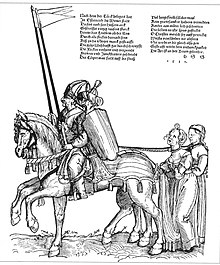
Between 1517 and 1917, most of the Middle East consisted of the Ottoman Empire. In the Ottoman capital of Constantinople, about one-fifth of the population consisted of slaves.[79] The city was a major centre of the slave trade in the 15th and later centuries.
Eastern European slaves were provided to the Ottoman Empire via the Crimean slave trade by Tatar raids on Slavic villages[296] but also by conquest and the suppression of rebellions, in the aftermath of which entire populations were sometimes enslaved and sold across the Empire, reducing the risk of future rebellion. The Ottomans also purchased slaves from traders who brought slaves into the Empire from Europe and Africa. It has been estimated that some 200,000 slaves – mainly Circassians – were imported into the Ottoman Empire between 1800 and 1909.[227] In 1908, women slaves were still sold in the Ottoman Empire.[297] German orientalist, Gustaf Dalman, reported seeing slaves in Muslim houses in Aleppo, belonging to Ottoman Syria, in 1899, and that boys could be bought as slaves in Damascus and Cairo in as late as 1909.[298]
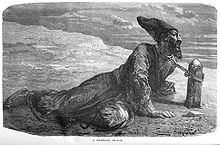
A major center of slave trade to the Middle east was central Asia, where the Bukhara slave trade had supplied slaves to the Middle East for thousands of years from antiquity until the 1870s. A slave market for captured Russian and Persian slaves was the Khivan slave trade centred in the Central Asian khanate of Khiva.[299] In the early 1840s, the population of the Uzbek states of Bukhara and Khiva included about 900,000 slaves.[227]
By 1870, chattel slavery had been at least formally banned in most areas of the world, with the exception of Muslim lands in Caucasus, Africa, and the Gulf.[300] While slavery was by the 1870s viewed as morally unacceptable in the West, slavery was not considered to be imoral in the Muslim world since it was an institution recognized in the Quran and morally justified under the guise of warfare against non-Muslims, and non-Muslims were kidnapped and enslaved by Muslims around the Muslim world: in the Balkans, the Caucasus, the Baluchistan, India, South West Asia and the Philippines.[300] Slaves where marsched in schackles to the coasts of Sudan, Ethiopia and Somali, placed upon dhows and trafficked across the Indian Ocean to the Gulf or Aden, or across the Red Sea to Arabia and Aden, while weak slaves being thrown in the sea; or across the Sahara desert via the Trans-Saharan slave trade to the Nile, while dying from exposure and swollen feet.[300]
Ottoman anti slavery laws where not enforced in the late 19th-century, particularly not in Hejaz; the first attempt to ban the Red Sea slave trade in 1857 resulted in a rebellion in the Hejaz Province, which resulted in Hejza exempted from the ban.[301] The Anglo-Ottoman Convention of 1880 formally banned the Red Sea slave trade, but it was not enforced in the Ottoman Provinces in the Arabian Peninsula.[301] In the late 19th-century, the Sultan of Morocco stated to Western diplomats that it was impossible for him to ban slavery because such a ban would not be enforcable, but the British asked him to ensure that the slave trade in Morocco would at least be handled discreet and away from the eyes of foreign wittnesses.[301]
Chattel slavery lasted in most of the Middle East until the 20th-century. The Red Sea slave trade still provided enslaved people from Africa to the Arabian Peninsula after World War II. As recently as the 1960s, Saudi Arabia's slave population was estimated at 300,000.[302] Along with Yemen, the Saudis abolished slavery in 1962.[303]
Contemporary slavery

Even though slavery is now outlawed in every country, the number of slaves today is estimated as between 12 million and 29.8 million.[304][305][306] According to a broad definition of slavery, there were 27 million people in slavery in 1999, spread all over the world.[307] In 2005, the International Labour Organization provided an estimate of 12.3 million forced labourers.[308] Siddharth Kara has also provided an estimate of 28.4 million slaves at the end of 2006 divided into three categories: bonded labour/debt bondage (18.1 million), forced labour (7.6 million), and trafficked slaves (2.7 million).[69] Kara provides a dynamic model to calculate the number of slaves in the world each year, with an estimated 29.2 million at the end of 2009.

According to a 2003 report by Human Rights Watch, an estimated 15 million children in debt bondage in India work in slavery-like conditions to pay off their family's debts.[310][311]
Slavoj Žižek asserts that new forms of contemporary slavery have been created in the post-Cold War era of global capitalism, including migrant workers deprived of basic civil rights on the Arabian Peninsula, the total control of workers in Asian sweatshops and the use of forced labor in the exploitation of natural resources in Central Africa.[312]
Distribution
In June 2013, U.S. State Department released a report on slavery. It placed Russia, China, and Uzbekistan in the worst offenders category. Cuba, Iran, North Korea, Sudan, Syria, and Zimbabwe were at the lowest level. The list also included Algeria, Libya, Saudi Arabia and Kuwait among a total of 21 countries.[313][314]
In Kuwait, there are more than 600,000 migrant domestic workers who are vulnerable to forced labor and legally tied to their employers, who often illegally take their passports.[315] In 2019, online slave markets on apps such as Instagram were uncovered.[316]
In the preparations for the 2022 World Cup in Qatar, thousands of Nepalese, the largest group of labourers, faced slavery in the form of denial of wages, confiscation of documents, and inability to leave the workplace.[317] In 2016, the United Nations gave Qatar 12 months to end migrant worker slavery or face investigation.[318]
The Walk Free Foundation reported in 2018 that slavery in wealthy Western societies is much more prevalent than previously known, in particular the United States and Great Britain, which have 403,000 (one in 800) and 136,000 slaves respectively. Andrew Forrest, founder of the organization, said that "The United States is one of the most advanced countries in the world yet has more than 400,000 modern slaves working under forced labour conditions."[319] An estimated 40.3 million are enslaved globally, with North Korea having the most slaves at 2.6 million (one in 10). Of the estimated 40.3 million people in contemporary slavery, 71% are women and 29% are men. The report found of the 40.3 million in modern slavery, 15.4 million are in forced marriages and 24.9 million are in forced labor.[320] The foundation defines contemporary slavery as "situations of exploitation that a person cannot refuse or leave because of threats, violence, coercion, abuse of power, or deception."[321]
China
In March 2020, the Chinese government was found to be using the Uyghur minority for forced labour, inside sweat shops. According to a report published then by the Australian Strategic Policy Institute (ASPI), no fewer than around 80,000 Uyghurs were forcibly removed from the region of Xinjiang and used for forced labour in at least twenty-seven corporate factories.[322] According to the Business and Human Rights resource center, corporations such as Abercrombie & Fitch, Adidas, Amazon, Apple, BMW, Fila, Gap, H&M, Inditex, Marks & Spencer, Nike, North Face, Puma, PVH, Samsung, and UNIQLO have each sourced products from these factories prior to the publication of the ASPI report.[323]
Libya
During the Second Libyan Civil War, Libyans started capturing Sub-Saharan African migrants trying to get to Europe through Libya and selling them on slave markets or holding them hostage for ransom[324] Women are often raped, used as sex slaves, or sold to brothels.[325][326][327] Child migrants suffer from abuse and child rape in Libya.[328][329]
Mauritania
In Mauritania, the last country to abolish slavery (in 1981), it is estimated that 20% of its population of 3 million people are enslaved as bonded labourers.[330][331][332] Slavery in Mauritania was criminalized in August 2007.[333] However, although slavery, as a practice, was legally banned in 1981, it was not a crime to own a slave until 2007.[334] Although many slaves have escaped or have been freed since 2007, as of 2012[update], only one slave owner had been sentenced to serve time in prison.[335]
North Korea
North Korea's human rights record is often considered to be the worst in the world and has been globally condemned, with the United Nations, the European Union and groups such as Human Rights Watch all critical of the country's record. Forms of torture, forced labour, and abuses are all widespread. Most international human rights organizations consider North Korea to have no contemporary parallel[336] with respect to violations of liberty.[337][338][339][340]
Taiwan
Taiwan's migrant worker population—estimated in 2018 to be up to 660,000 in number—have reportedly faced slavery-like conditions involving sexual abuse in the domestic work sector[341] and forced labor in fishing sectors.[342][343] Taiwan is among a minority of places in the world that legally allows labor brokers to charge migrant workers for services which elsewhere are covered by employers as human resource costs.[344] A few Taiwanese universities have reportedly tricked students from Eswatini,[345] Uganda and Sri Lanka into forced labour at factories as payment for the university programs.[346] Some charity groups in 2007 also insisted that foreign women—mostly from China and Southeast Asia—were being forced into prostitution, although local police in Tainan disagreed and said they deliberately came to Taiwan "to sell sex".[347]
Economics
While American slaves in 1809 were sold for around $40,000 (in inflation adjusted dollars), a slave nowadays can be bought for just $90, making replacement more economical than providing long-term care.[348] Slavery is a multibillion-dollar industry with estimates of up to $35 billion generated annually.[349]
Trafficking
Victims of human trafficking are typically recruited through deceit or trickery (such as a false job offer, false migration offer, or false marriage offer), sale by family members, recruitment by former slaves, or outright abduction. Victims are forced into a "debt slavery" situation by coercion, deception, fraud, intimidation, isolation, threat, physical force, debt bondage or even force-feeding with drugs to control their victims.[350] "Annually, according to U.S. government-sponsored research completed in 2006, approximately 800,000 people are trafficked across national borders, which does not include millions trafficked within their own countries. Approximately 80% of transnational victims are women and girls, and up to 50% are minors, reports the U.S. State Department in a 2008 study.[351]
While the majority of trafficking victims are women who are forced into prostitution (in which case the practice is called sex trafficking), victims also include men, women and children who are forced into manual labour.[352] Because of the illegal nature of human trafficking, its extent is unknown. A U.S. government report, published in 2005, estimates that about 700,000 people worldwide are trafficked across borders each year. This figure does not include those who are trafficked internally.[352] Another research effort revealed that roughly 1.5 million individuals are trafficked either internally or internationally each year, of which about 500,000 are sex trafficking victims.[69]
Abolitionism
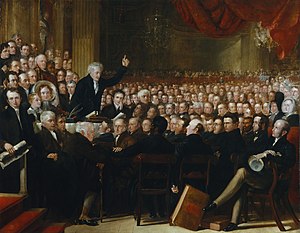
Slavery has existed, in one form or another, throughout recorded human history – as have, in various periods, movements to free large or distinct groups of slaves.[citation needed]
In antiquity

Emperor Ashoka, who ruled the Maurya Empire in the Indian subcontinent from 269 to 232 BCE, abolished the slave trade but not slavery.[354] The Qin dynasty, which ruled China from 221 to 206 BC, abolished slavery and discouraged serfdom. However, many of its laws were overturned when the dynasty was overthrown.[355] Slavery was again abolished by Wang Mang in China in 17 CE but was reinstituted after his assassination.[356]
Americas
The Spanish colonization of the Americas sparked a discussion about the right to enslave Native Americans. A prominent critic of slavery in the Spanish New World colonies was the Spanish missionary and bishop, Bartolomé de las Casas, who was "the first to expose the oppression of indigenous peoples by Europeans in the Americas and to call for the abolition of slavery there."[357]
In the United States, all of the northern states had abolished slavery by 1804, with New Jersey being the last to act.[358] Abolitionist pressure produced a series of small steps towards emancipation. After the Act Prohibiting Importation of Slaves went into effect on January 1, 1808, the importation of slaves into the United States was prohibited,[359] but not the internal slave trade, nor involvement in the international slave trade externally. Legal slavery persisted outside the northern states; most of those slaves already in the U.S. were legally emancipated only in 1863. Many American abolitionists took an active role in opposing slavery by supporting the Underground Railroad. Violent clashes between anti-slavery and pro-slavery Americans included Bleeding Kansas, a series of political and armed disputes in 1854–1858 as to whether Kansas would join the United States as a slave or free state. By 1860, the total number of slaves reached almost four million, and the American Civil War, beginning in 1861, led to the end of slavery in the United States.[360] In 1863, Lincoln issued the Emancipation Proclamation, which freed slaves held in the Confederate States; the 13th Amendment to the U.S. Constitution prohibited most forms of slavery throughout the country.
Many of the freed slaves became sharecroppers and indentured servants. In this manner, some became tied to the very parcel of land into which they had been born a slave having little freedom or economic opportunity because of Jim Crow laws which perpetuated discrimination, limited education, promoted persecution without due process and resulted in continued poverty. Fear of reprisals such as unjust incarcerations and lynchings deterred upward mobility further.
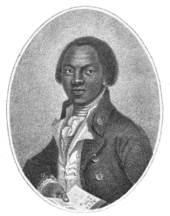
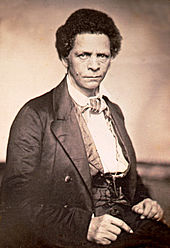
Europe
France abolished slavery in 1794 during the Revolution,[361] but it was restored in 1802 under Napoleon.[362] It has been asserted that, before the Revolution, slavery was illegal in metropolitan France (as opposed to its colonies),[363] but this has been refuted.[364]
One of the most significant milestones in the campaign to abolish slavery throughout the world occurred in England in 1772, with British Judge Lord Mansfield, whose opinion in Somersett's Case was widely taken to have held that slavery was illegal in England. This judgement also laid down the principle that slavery contracted in other jurisdictions could not be enforced in England.[365]
Sons of Africa was a late 18th-century British group that campaigned to end slavery. Its members were Africans in London, freed slaves who included Ottobah Cugoano, Olaudah Equiano and other leading members of London's black community. It was closely connected to the Society for Effecting the Abolition of the Slave Trade, a non-denominational group founded in 1787, whose members included Thomas Clarkson. British Member of Parliament William Wilberforce led the anti-slavery movement in the United Kingdom, although the groundwork was an anti-slavery essay by Clarkson. Wilberforce was urged by his close friend, Prime Minister William Pitt the Younger, to make the issue his own and was also given support by reformed Evangelical John Newton. The Slave Trade Act was passed by the British Parliament on March 25, 1807, making the slave trade illegal throughout the British Empire,[366] Wilberforce also campaigned for abolition of slavery in the British Empire, which he lived to see in the Slavery Abolition Act 1833.
After the 1807 act abolishing the slave trade was passed, these campaigners switched to encouraging other countries to follow suit, notably France and the British colonies. Between 1808 and 1860, the British West Africa Squadron seized approximately 1,600 slave ships and freed 150,000 Africans who were aboard.[367] Action was also taken against African leaders who refused to agree to British treaties to outlaw the trade, for example against "the usurping King of Lagos", deposed in 1851. Anti-slavery treaties were signed with over 50 African rulers.[368]
Worldwide
In 1839, the world's oldest international human rights organization, Anti-Slavery International, was formed in Britain by Joseph Sturge, which campaigned to outlaw slavery in other countries.[369] There were celebrations in 2007 to commemorate the 200th anniversary of the abolition of the slave trade in the United Kingdom through the work of the British Anti-Slavery Society.
In the 1860s, David Livingstone's reports of atrocities within the Arab slave trade in Africa stirred up the interest of the British public, reviving the flagging abolitionist movement. The Royal Navy throughout the 1870s attempted to suppress "this abominable Eastern trade", at Zanzibar in particular. In 1905, the French abolished indigenous slavery in most of French West Africa.[370]
On December 10, 1948, the United Nations General Assembly adopted the Universal Declaration of Human Rights, which declared freedom from slavery is an internationally recognized human right. Article 4 of the Universal Declaration of Human Rights states:
No one shall be held in slavery or servitude; slavery and the slave trade shall be prohibited in all their forms.[371]
In 2014, for the first time in history, major leaders of many religions, Buddhist, Hindu, Christian, Jewish, and Muslim met to sign a shared commitment against modern-day slavery; the declaration they signed calls for the elimination of slavery and human trafficking by 2020.[372] The signatories were: Pope Francis, Mātā Amṛtānandamayī, Bhikkhuni Thich Nu Chân Không (representing Zen Master Thích Nhất Hạnh), Datuk K Sri Dhammaratana, Chief High Priest of Malaysia, Rabbi Abraham Skorka, Rabbi David Rosen, Abbas Abdalla Abbas Soliman, Undersecretary of State of Al Azhar Alsharif (representing Mohamed Ahmed El-Tayeb, Grand Imam of Al-Azhar), Grand Ayatollah Mohammad Taqi al-Modarresi, Sheikh Naziyah Razzaq Jaafar, Special advisor of Grand Ayatollah (representing Grand Ayatollah Sheikh Basheer Hussain al Najafi), Sheikh Omar Abboud, Justin Welby, Archbishop of Canterbury, and Metropolitan Emmanuel of France (representing Ecumenical Patriarch Bartholomew.)[372]
Groups such as the American Anti-Slavery Group, Anti-Slavery International, Free the Slaves, the Anti-Slavery Society, and the Norwegian Anti-Slavery Society continue to campaign to eliminate slavery.[citation needed]
UNESCO has been working to break the silence surrounding the memory of slavery since 1994, through The Slave Route Project.[373]
Apologies
On May 21, 2001, the National Assembly of France passed the Taubira law, recognizing slavery as a crime against humanity. Apologies on behalf of African nations, for their role in trading their countrymen into slavery, remain an open issue since slavery was practiced in Africa even before the first Europeans arrived and the Atlantic slave trade was performed with a high degree of involvement of several African societies. The black slave market was supplied by well-established slave trade networks controlled by local African societies and individuals.[374]
There is adequate evidence citing case after case of African control of segments of the trade. Several African nations such as the Calabar and other southern parts of Nigeria had economies depended solely on the trade. African peoples such as the Imbangala of Angola and the Nyamwezi of Tanzania would serve as middlemen or roving bands warring with other African nations to capture Africans for Europeans.[375]
Several historians have made important contributions to the global understanding of the African side of the Atlantic slave trade. By arguing that African merchants determined the assemblage of trade goods accepted in exchange for slaves, many historians argue for African agency and ultimately a shared responsibility for the slave trade.[376]
In 1999, President Mathieu Kérékou of Benin issued a national apology for the central role Africans played in the Atlantic slave trade.[117] Luc Gnacadja, minister of environment and housing for Benin, later said: "The slave trade is a shame, and we do repent for it."[377] Researchers estimate that 3 million slaves were exported out of the Slave Coast bordering the Bight of Benin.[377] President Jerry Rawlings of Ghana also apologized for his country's involvement in the slave trade.[117]
The issue of an apology is linked to reparations for slavery and is still being pursued by entities across the world. For example, the Jamaican Reparations Movement approved its declaration and action plan. In 2007, British Prime Minister Tony Blair made a formal apology for Great Britain's involvement in slavery.[378]
On February 25, 2007, the Commonwealth of Virginia resolved to 'profoundly regret' and apologize for its role in the institution of slavery. Unique and the first of its kind in the U.S., the apology was unanimously passed in both Houses as Virginia approached the 400th anniversary of the founding of Jamestown.[379]
On August 24, 2007, Mayor of London Ken Livingstone issued a public apology for London's role in Atlantic slave trade, which took place at an event commemorating the 200th anniversary of the British slave trade's abolition. In his speech, Livingstone described the slave trade as "the racial murder of not just those who were transported but generations of enslaved African men, women and children. To justify this murder and torture black people had to be declared inferior or not human... We live with the consequences today."[380] City officials in Liverpool, which was a large slave trading port, apologized in 1999.[381]
On July 30, 2008, the United States House of Representatives passed a resolution apologizing for American slavery and subsequent discriminatory laws.[382] In June 2009, the U.S. Senate passed a resolution apologizing to African-Americans for the "fundamental injustice, cruelty, brutality, and inhumanity of slavery". The news was welcomed by President Barack Obama, the nation's first president of African descent.[383] Some of President Obama's ancestors may have been slave owners.[384]
In 2010, Libyan leader Muammar Gaddafi apologized for Arab involvement in the slave trade, saying: "I regret the behavior of the Arabs... They brought African children to North Africa, they made them slaves, they sold them like animals, and they took them as slaves and traded them in a shameful way."[385]
Reparations
There have been movements to achieve reparations for those formerly held as slaves or for their descendants. Claims for reparations for being held in slavery are handled as a civil law matter in almost every country. This is often decried as a serious problem, since former slaves' relatives lack of money means they often have limited access to a potentially expensive and futile legal process. Mandatory systems of fines and reparations paid to an as yet undetermined group of claimants from fines, paid by unspecified parties, and collected by authorities have been proposed by advocates to alleviate this "civil court problem." Since in almost all cases there are no living ex-slaves or living ex-slave owners these movements have gained little traction. In nearly all cases the judicial system has ruled that the statute of limitations on these possible claims has long since expired.
In June 2023, The Brattle Group presented a report at an event at the University of the West Indies in which reparations were estimated, for harms both during and after the period of transatlantic chattel slavery, at over 100 trillion dollars.[386][387]
Media
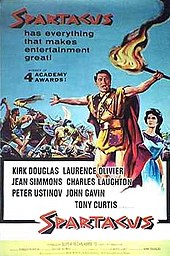
Film has been the most influential medium in the presentation of the history of slavery to the general public around the world.[388] The American film industry has had a complex relationship with slavery and until recent decades often avoided the topic. Films such as The Birth of a Nation (1915)[389] and Gone with the Wind (1939) became controversial because they gave a favourable depiction. In 1940 The Santa Fe Trail gave a liberal but ambiguous interpretation of John Brown's attacks on slavery.[390] Song of the South gave a favorable outlook on slavery in the United States in 1946.[citation needed]
The Civil Rights Movement in the 1950s made defiant slaves into heroes.[391] The question of slavery in American memory necessarily involves its depictions in feature films.[392]
Most Hollywood films used American settings, although Spartacus (1960), dealt with an actual revolt in the Roman Empire known as the Third Servile War. The revolt failed, and all the rebels were executed, but their spirit lived on according to the film.[393] Spartacus stays surprisingly close to the historical record.[394]
The Last Supper (La última cena in Spanish) was a 1976 film directed by Cuban Tomás Gutiérrez Alea about the teaching of Christianity to slaves in Cuba, and emphasizes the role of ritual and revolt. Burn! takes place on the imaginary Portuguese island of Queimada (where the locals speak Spanish) and it merges historical events that took place in Brazil, Cuba, Santo Domingo, Jamaica, and elsewhere.
Historians agree that films have largely shaped historical memories, but they debate issues of accuracy, plausibility, moralism, sensationalism, how facts are stretched in search of broader truths, and suitability for the classroom.[395][393] Berlin argues that critics complain if the treatment emphasizes historical brutality, or if it glosses over the harshness to highlight the emotional impact of slavery.[396]
See also
- Bodmin manumissions, the names and details of slaves freed in Medieval Bodmin
- Christian Ritual and the Creation of British Slave Societies, 1650-1780
- International Day for the Abolition of Slavery
- International Slavery Museum
- Involuntary servitude
- List of slaves
- List of slave owners
- Mukataba
- Slave rebellion
- Supplementary Convention on the Abolition of Slavery
- Wilberforce Institute for the Study of Slavery and Emancipation
References
- ^ Allain, Jean (2012). "The Legal Definition of Slavery into the Twenty-First Century". In Allain, Jean (ed.). The Legal Understanding of Slavery: From the Historical to the Contemporary. Oxford: Oxford University Press. pp. 199–219. ISBN 978-0-19-164535-8.
- ^ Baker-Kimmons, Leslie C. (2008). "Slavery". In Schaefer, Richard T. (ed.). Encyclopedia of Race, Ethnicity, and Society. Vol. 3. SAGE Publishing. p. 1234. ISBN 9781412926942.
- ^ Jump up to: a b c d e f g "Historical survey: Slave-owning societies". Encyclopædia Britannica. Archived from the original on February 23, 2007.
- ^ Bales 2004, p. 4.
- ^ White, Shelley K.; White, Jonathan M.; Korgen, Kathleen Odell (2014). Sociologists in Action on Inequalities: Race, Class, Gender, and Sexuality. SAGE Publishing. p. 43. ISBN 978-1-4833-1147-0.
- ^ Jump up to: a b "Slavery in the 21st century". Newint.org. Archived from the original on May 27, 2010. Retrieved August 29, 2010.
- ^ Okeowo, Alexis (September 8, 2014). "Freedom Fighter: A slaving society and an abolitionist's crusade". The New Yorker. Archived from the original on January 6, 2018. Retrieved October 16, 2014.
- ^ Corrigan, Terence (September 6, 2007). "Mauritania: Country Made Slavery Illegal Last Month". The East African Standard. Archived from the original on August 4, 2011. Retrieved January 21, 2008.
- ^ Hodal, Kate (May 31, 2016). "One in 200 people is a slave. Why?". The Guardian. Archived from the original on April 30, 2019.
- ^ "Religion & Ethics – Modern slavery: Modern forms of slavery". BBC. January 30, 2007. Archived from the original on January 6, 2014. Retrieved June 16, 2009.
- ^ "slave". Oxford English Dictionary (2nd ed.). 1989.
- ^ Jankowiak, Marek (February 2017). "What Does the Slave Trade in the Saqaliba Tell Us about Early Islamic Slavery?". International Journal of Middle East Studies. 49 (1): 169–172. doi:10.1017/S0020743816001240. ISSN 0020-7438.
- ^ "The international slave trade". Encyclopædia Britannica.
- ^ Lewis 1992, Chapter 1.
- ^ Kluge, Friedrich (1899). "Artikel Sklave" [Article Slave]. Etymologisches Wörterbuch Der Deutschen Sprache [Etymological dictionary of the German language] (in German) (6 ed.). Strassburg: Trübner. p. 366.
- ^ Dostoevsky, Fyodor (1981). "Самое последнее слово цивилизации". In В. Г. Базанов и др., ИРЛИ (ed.). Polnoye sobraniye sochineniy. V 30 tomakh Полное собрание сочинений. В 30 томах [Full composition of writings. In 30 volumes] (in Russian). Vol. 23. Дневник писателя за 1876 год. Май-октябрь. Leningrad: Наука. Ленингр. отд-ние. pp. 63, 382. Archived from the original on May 20, 2018.
- ^ Korth, Georg (1970). "Zur Etymologie des Wortes 'Slavus' (Sklave)" [On the etymology of the word 'Slavus' (slave)]. Glotta, Zeitschrift fur Griechische und Lateinische Sprache (in German). 48 (1/2). Göttingen: Vandenhoeck & Ruprecht (GmbH & Co. KG): 145–153. JSTOR 40266114.
- ^ Kluge, Friedrich (1989). "Artikel Sklave". In Elmar Seebold (ed.). Etymologisches Wörterbuch Der Deutschen Sprache (in German) (22 ed.). Berlin & New York: De Gruyter. p. 676. ISBN 3-11-006800-1.
- ^ Köbler, Gerhard (1995). "Sklave" [Slave]. Deutsches Etymologisches Rechtswörterbuch [German Etymological Legal Dictionary] (in German). Tübingen: Mohr. p. 371. ISBN 978-3-8252-1888-1.
- ^ Scholten, Daniel (2020). "Sklave und Slawe" [Slave and Slav]. Deutsch für Dichter und Denker: Unsere Muttersprache in neuem Licht [German for poets and thinkers: Our mother tongue in a new light] (in German). Bright Star Books. ISBN 978-3-948287-06-1. Archived from the original on October 24, 2020.
- ^ Ditten, Hans (1972). "Kritik an G. Korth". Byzantinoslavica. Vol. 33. Prague: Academia, de l'Academie Tchecoslovaque des Sciences et Lettres. pp. 183–184.
- ^ Waldman, Katy (May 19, 2015). "Slave or Enslaved Person? It's not just an academic debate for historians of American slavery". Slate. Archived from the original on May 21, 2015.
- ^ Brace, Laura (2004). The Politics of Property: Labour, Freedom and Belonging. Edinburgh University Press. p. 162. ISBN 978-0-7486-1535-3. Retrieved May 31, 2012.
- ^ Keith Bradley (March 7, 2016). "slavery, Roman". Oxford Classical Dictionary. Oxford University Press. doi:10.1093/acrefore/9780199381135.013.7311. ISBN 978-0-19-938113-5. Retrieved June 27, 2023.
chattel-slavery, whereby the slave‐owner enjoyed complete mastery (dominium) over the slave's physical being […] was evident throughout the central era of Roman history, and in Roman no less than Greek thought was regarded as both the necessary antithesis of civic freedom
- ^ Bradley, Keith (November 2, 2020). "'The Bitter Chain of Slavery': Reflections on Slavery in Ancient Rome". Harvard University. Archived from the original on April 11, 2021. Retrieved November 15, 2022.
- ^ Finley, Moses I. (1980). Ancient Slavery and Modern Ideology. Viking Press. p. 71. ISBN 9780670122776.
- ^ Alexander, J. (2001). "Islam, Archaeology and Slavery in Africa". World Archaeology. 33 (1): 51. doi:10.1080/00438240120047627. JSTOR 00438243.
Chattel-slaves were needed, especially from the ninth to thirteenth centuries, in the gold and emerald (carbuncle) mines of the Wadi Allaqi in the deserts east of the Nile's 2nd Cataract
- ^ Burkholder, Mark A.; Johnson, Lyman L. (2019). "1. America, Iberia, and Africa Before the Conquest". Colonial Latin America (10th ed.). Oxford University Press. p. 10.
Wealth rested heavily on the possession of slaves across the large empires of West Africa as well as in Benin and other kingdoms […] Slave owners in sub-Saharan Africa also employed their chattel in a variety of occupations.
- ^ Bergad, Laird W. (2007). The Comparative Histories of Slavery in Brazil, Cuba, and the United States. New York: Cambridge University Press. pp. 57, 132, 165, 166. ISBN 9780521872355.
- ^ Slavery and Social Death : A Comparative Study, Orlando (1982). Patterson. Cambridge, Mass.: Harvard University Press. pp. X. ISBN 9780674986909.
- ^ Wendy Warren (2016). New England Bound (1st. ed.). W. W. Norton & Company. pp. 110–111. ISBN 978-0-87140-672-9.
the Iroquois confederacy, people who practiced a form of captive taking that in some ways looked very like chattel slavery
- ^ "Traditional or Chattel Slavery". FSE Project. The Feminist Sexual Ethics Project. Retrieved August 31, 2014.
- ^ Jump up to: a b c Miers, S. (2003). Slavery in the Twentieth Century: The Evolution of a Global Problem. USA: AltaMira Press.
- ^ Jump up to: a b Bales 2004, pp. 15–18.
- ^ "Debt bondage remains the most prevalent form of forced labour worldwide". United Nations. September 15, 2016. Retrieved July 27, 2021.
- ^ "Nigeria's young daughters are sold as 'money wives'". Al Jazeera. September 21, 2018. Retrieved May 12, 2020.
- ^ Sleightholme; Indrani (1996). Guilty Without Trial. Rutgers University Press. pp. 11–12. ISBN 0-8135-2381-8.
- ^ Chatterjee, Indrani; Eaton, Richard (2006). Slavery and South Asian History. Indiana University Press. p. 3. ISBN 978-0-253-11671-0.
- ^ Dandamayev, M. A.; Barda; Bardadārī. Encyclopædia Iranica.
- ^ Farazmand, Ali (1998). "Persian/Iranian Administrative Tradition". In Shafritz, Jay M. (ed.). International Encyclopedia of Public Edict and Administration. Boulder, CO: Westview Press. pp. 1640–1645 (1642).
Persians never practiced mass slavery, and in many cases the situations and lives of semi-slaves (prisoners of war) were in fact better than the common citizens of Persia.
- ^ "Experts encourage action against sex trafficking". November 2, 2009. Archived from the original on December 23, 2009.
- ^ "Rights–Mexico: 16,000 Victims of Child Sexual Exploitation". ipsnews.net. August 13, 2007. Retrieved February 11, 2016.
- ^ "Campaign Page: Child Soldiers". Human Rights Watch. June 2001. Archived from the original on February 13, 2008. [verification needed]
- ^ Sullivan, Kevin (December 26, 2008). "In Togo, a 10-Year-Old's Muted Cry: 'I Couldn't Take Any More'". Archived from the original on June 12, 2018. Retrieved January 15, 2024.
- ^ "Two-year-old 'at risk' of forced marriage". BBC News. March 5, 2013.
- ^ "Honor Diaries: Child/Forced Marriage: Factsheet" (PDF). Honordiaries.com. Archived from the original (PDF) on September 24, 2015. Retrieved September 29, 2015.
- ^ Black, Debra (September 20, 2013). "Forced marriages rampant in Ontario". The Hamilton Spectator. Archived from the original on March 26, 2017. Retrieved September 20, 2013.
- ^ "Without Consent: Forced Marriage in Australia" (PDF). Archived (PDF) from the original on June 13, 2015.
- ^ "UNICEF supports fight to end marriage by abduction in Ethiopia". reliefweb.int. November 9, 2004. Retrieved August 29, 2013.
- ^ Krembs, Peter (January 20, 2003). "An Idea Not Worth Drafting: Conscription is Slavery". Capmag.com. Retrieved September 29, 2015.
- ^ Kopel, Dave. "Nationalized Slavery; A policy Italy should dump". davidkopel.com. Archived from the original on October 12, 2007.. Refers to both the military and national service requirements of Italy as slavery
- ^ Machan, Tibor R. (April 13, 2000). "Tax Slavery". Ludwig von Mises Institute. Retrieved October 9, 2006.
- ^ Valenstein, Elliot (2002). Blaming the Brain: The Truth About Drugs and Mental Health. Simon & Schuster. p. 26. ISBN 978-0-7432-3787-1.
- ^ Szasz, Thomas Stephen. Psychiatric Slavery. Retrieved September 29, 2015 – via Google Books.
- ^ Schaler, J. A. (2003). "Slavery and psychiatry". British Journal of Psychiatry. 183: 77–78. doi:10.1192/bjp.183.1.77-a. PMID 12835252.
- ^ Spiegel, Marjorie (1996). The Dreaded Comparison: Human and Animal Slavery. New York: Mirror Books.
- ^ For sources about the concept of "wage slavery" and its various interpretations, see "wage slave". dictionary.com. Retrieved March 4, 2013.
- ^ Ellerman 1992.
- ^ "wage slave". merriam-webster.com. Retrieved March 4, 2013.
- ^ "Constitution Society – Advocates and enforcers of the U.S. and State Constitutions". Retrieved February 6, 2021.
...vulgar are the means of livelihood of all hired workmen whom we pay for mere manual labour, not for artistic skill; for in their case the very wage they receive is a pledge of their slavery.
- ^ North, Douglass C.; Thomas, Robert Paul (December 1971). "The Rise and Fall of the Manorial System: A Theoretical Model". The Journal of Economic History. 31 (4): 777–803. doi:10.1017/S0022050700074623. JSTOR 2117209. S2CID 154616683.
- ^ Domar, Evsey D. (March 1970). "The Causes of Slavery or Serfdom: A Hypothesis". The Journal of Economic History. 30 (1): 18–32. doi:10.1017/S0022050700078566. JSTOR 2116721. S2CID 154921369.
- ^ Lagerlöf, Nils-Petter (November 12, 2006). "Slavery and other property rights". MPRA Paper 372. Retrieved May 6, 2009.
- ^ "Technology". History.com. January 4, 2008. Archived from the original on April 23, 2008. Retrieved May 6, 2009.
- ^ Helper, Hinton Rowan (1857). The Impending Crisis of the South: How to Meet It. New York: Burdick Brothers.
- ^ McKivigan, John R.; Snay, Mitchell (1998). Religion and the Antebellum Debate Over Slavery. University of Georgia Press. p. 68. ISBN 978-0-8203-2076-2. Retrieved May 31, 2012.
- ^ Griswold, Charles L. (1999). Adam Smith and the Virtues of Enlightenment. Cambridge University Press. p. 198. ISBN 978-0-521-62891-4. Retrieved May 31, 2012.
- ^ Forbes 1998, p. 74.
- ^ Jump up to: a b c Kara, Siddharth (2008). Sex Trafficking – Inside the Business of Modern Slavery. Columbia University Press. ISBN 978-0-231-13960-1.
- ^ "Louis Dor (Saturday 30 April 2016) Kim Jong-un is recruiting a new 'pleasure squad' of teenage girls". April 30, 2016.
- ^ Ryall, Julian (April 2, 2015). "Kim Jong-un brings back 'pleasure troupe' entertainers". The Telegraph.
- ^ "From private to state slavery and back again". Eurozine. July 31, 2017. Retrieved August 12, 2021.
- ^ Lockhart, James; Schwartz, Stuart. Early Latin America. New York: Cambridge University Press. p. 138.
The encomienda in its early heyday granted a lifetime monopoly on the utilization of temporary Indian labor in a given area to one Spaniard, the encomendero.
- ^ "One day we will start a big war". Foreign Policy. Archived from the original on February 5, 2017. Retrieved February 13, 2017.
- ^ Stengers, Jean (1969). "The Congo Free State and the Belgian Congo before 1914". In Gann, L. H.; Duignan, Peter (eds.). Colonialism in Africa, 1870–1914. Vol. I. Cambridge: Cambridge University Press. p. 272.
- ^ Pollak, Michael (March 28, 2014). "Determining the Legal Rights of Slaves". The New York Times. ISSN 0362-4331. Retrieved February 11, 2021.
- ^ Ober, Josiah (June 26, 2018). Athenian Legacies: Essays on the Politics of Going On Together. Princeton University Press. ISBN 978-0-691-19016-7.
- ^ Cobb, Thomas (1999) [1858]. An Inquiry into the Law of Negro Slavery in the United States of America. University of Georgia Press. pp. 268–269.
- ^ Jump up to: a b Hellie, Richard (May 6, 2023). "Slavery". Encyclopædia Britannica.
- ^ Harris, W. V. (February 3, 2011). Demography, Geography, and the Sources of Roman Slaves. Oxford University Press. pp. 88–110. doi:10.1093/acprof:osobl/9780199595167.003.0005. ISBN 978-0-19-959516-7.
{{cite book}}:|work=ignored (help) - ^ Perbi, Akosua (April 5, 2001). "Slavery and the Slave Trade in Pre-colonial Africa" (PDF). latinamericanstudies.org. Retrieved August 11, 2016.
- ^ "Welcome to Encyclopædia Britannica's Guide to Black History". Britannica.com. Archived from the original on December 30, 2007. Retrieved March 19, 2018.
- ^ Bindman, David; Gates (Jr.), Henry Louis; Dalton, Karen C. C., eds. (2010). The Image of the Black in Western Art. Vol. 2. Belknap Press of Harvard University Press. p. 27. ISBN 978-0-674-05271-0.
- ^ Mohaiemen, Naeem (July 27, 2004). "Slaves in Saudi". The Daily Star. Vol. 5, no. 61. Retrieved February 7, 2021.
- ^ Ochiengʼ, William Robert (1975). Eastern Kenya and Its Invaders. East African Literature Bureau. p. 76. Retrieved May 15, 2015 – via Google Books.
- ^ Jump up to: a b Ogot, Bethwell A. (April 1970). "Zamani: a survey of East African history". African Affairs: 104. doi:10.1093/oxfordjournals.afraf.a096007. ISSN 1468-2621.
- ^ Jump up to: a b Lodhi, Abdulaziz (2000). Oriental influences in Swahili: a study in language and culture contacts. Acta Universitatis Gothoburgensis. p. 17. ISBN 978-91-7346-377-5.
- ^ "Focus on the slave trade". BBC. September 3, 2001. Archived from the original on May 25, 2017.
- ^ Fage, John Donnelly; Tordoff, William (2001). A History of Africa (4 ed.). Budapest: Routledge. p. 258. ISBN 978-0-415-25248-5.
- ^ Tannenbaum, Edward R.; Dudley, Guilford (1973). A History of World Civilizations. Wiley. p. 615. ISBN 978-0-471-84480-8.
- ^ Campbell 2004, p. ix.
- ^ Shillington, Kevin (July 4, 2013). Encyclopedia of African History 3-Volume Set. Routledge. p. 1401. ISBN 978-1-135-45670-2.
- ^ "Slow Death for Slavery: The Course of Abolition in Northern Nigeria, 1897–1936 (review)". Journal of World History. Archived from the original on April 11, 2016. Retrieved December 31, 2021.
- ^ ""Freedom is a good thing but it means a dearth of slaves": Twentieth Century Solutions to the Abolition of Slavery" (PDF). Archived from the original (PDF) on May 15, 2011. Retrieved August 29, 2010.
- ^ Bagley, H. R. C. (August 1, 1997). The Last Great Muslim Empires. BRILL. ISBN 978-90-04-02104-4.
- ^ Rodriguez 2007a, p. 585.
- ^ Asquith, Christina. "Revisiting the Zanj and Re-Visioning Revolt: Complexities of the Zanj Conflict – 868–883 AD – slave revolt in Iraq". Archived from the original on March 6, 2016.
- ^ "Islam, From Arab To Islamic Empire: The Early Abbasid Era". History-world.org. Archived from the original on September 24, 2018. Retrieved March 23, 2016.
- ^ Kissling, H. J.; Spuler, Bertold; Barbour, N.; Trimingham, J. S.; Braun, H.; Hartel, H. (August 1, 1997). The Last Great Muslim Empires. BRILL. ISBN 978-90-04-02104-4.
- ^ Syed, Muzaffar Husain (2011). A Concise History of Islam. New Delhi: VIJ Books (India) Pty Ltd. p. 453. ISBN 978-93-81411-09-4.
According to Robert Davis, from the 16th to 19th century, pirates captured 1 million to 1.25 million Europeans as slaves.
- ^ Davis, R. (September 16, 2003). Christian Slaves, Muslim Masters: White Slavery in the Mediterranean, The Barbary Coast, and Italy, 1500–1800. Palgrave Macmillan UK. ISBN 978-1-4039-4551-8 – via Google Books.
- ^ "When Europeans Were Slaves: Research Suggests White Slavery Was Much More Common Than Previously Believed". Research News. Archived from the original on July 25, 2011. Retrieved October 10, 2007.
- ^ Jump up to: a b Carroll, Rory (March 11, 2004). "New book reopens old arguments about slave raids on Europe". The Guardian. ISSN 0261-3077. Retrieved December 11, 2017.
- ^ Wright, John (2007). "Trans-Saharan Slave Trade". Routledge.
- ^ Davis, Robert (February 17, 2011). "British Slaves on the Barbary Coast". BBC.
- ^ Baepler, B. (January 1999). "White Slaves, African Masters: An Anthology of American Barbary Captivity Narratives". The SHAFR Guide Online. University of Chicago Press: 5. doi:10.1163/2468-1733_shafr_sim030170256.
- ^ "History – British History in depth: British Slaves on the Barbary Coast". BBC. Retrieved March 12, 2013.
- ^ "Swahili Coast". National Geographic. October 17, 2002. Archived from the original on December 30, 2007. Retrieved September 30, 2015.
- ^ "Remembering East African slave raids". BBC News. March 30, 2007. Retrieved February 6, 2021.
- ^ "Focus on the slave trade". BBC News. September 3, 2001. Retrieved February 6, 2021.
- ^ Campbell 2007, p. 173.
- ^ Veenhoven, Willem A. (1977). Case Studies on Human Rights And Fundamental Freedoms: A World Survey. Martinus Nijhoff Publishers. p. 440. ISBN 978-90-247-1956-3. Retrieved May 31, 2012.
- ^ Jump up to: a b Snell, Daniel C. (2011). "Slavery in the Ancient Near East". In Keith Bradley and Paul Cartledge (ed.). The Cambridge World History of Slavery. New York: Cambridge University Press. pp. 4–21.
- ^ Lovejoy, Paul E. (1989). "The Impact of the Atlantic Slave Trade on Africa: A Review of the Literature". Journal of African History: 30.
- ^ Foner, Eric (2012). Give Me Liberty: An American History. New York: W. W. Norton & Company. p. 18.
- ^ M'bokolo, Elikia (April 1, 1998). "The impact of the slave trade on Africa". Le Monde diplomatique. Retrieved February 7, 2021.
- ^ Jump up to: a b c Gates, Henry Louis Jr. (April 22, 2010). "Opinion | Ending the Slavery Blame-Game". The New York Times. ISSN 0362-4331. Retrieved February 13, 2021.
- ^ Bortolot, Alexander Ives. "The Transatlantic Slave Trade]". metmuseum.org. Retrieved February 6, 2021.
- ^ "Nigeria – The Slave Trade". countrystudies.us. U.S. Library of Congress. Archived from the original on February 7, 2021. Retrieved February 6, 2021.
- ^ Rubinstein, W. D. (2004). Genocide: a history. Pearson Education. pp. 76–78. ISBN 978-0-582-50601-5.
- ^ Mancke, Elizabeth; Shammas, Carole (May 31, 2005). The Creation of the British Atlantic World. Johns Hopkins University Press. pp. 30–31. ISBN 978-0-8018-8039-1.
- ^ "Aztec Social Structure". University of Texas at Austin. Archived from the original on February 23, 2011.
- ^ Lawson, Russell M.; Lawson, Benjamin A. (October 11, 2019). Race and Ethnicity in America: From Pre-contact to the Present [4 volumes]. ABC-CLIO. p. 16. ISBN 978-1-4408-5097-4.
- ^ "Slavery in the New World". Encyclopædia Britannica. Retrieved February 25, 2011.
- ^ Ames, Kenneth M. (June 2001). "Slaves, Chiefs and Labour on the Northern Northwest Coast". World Archaeology. 33 (The Archaeology of Slavery) (1): 1–17. doi:10.1080/00438240120047591. JSTOR 827885. S2CID 162278526.
- ^ Donald, Leland (1997). "Aboriginal Slavery on the Northwest Coast of North America". University of California Press. ISBN 978-0-520-91811-5. Retrieved December 25, 2019 – via Google Books.
- ^ "The World Factbook". CIA. Archived from the original on June 29, 2011. Retrieved August 8, 2010.
- ^ "Sicut Dudem -Against the Enslavement of Black Natives of the Canary Islands". papalencyclicals.net. January 13, 1435.
- ^ "Sublimus Dei – On the Enslavement and Evangelization of Indians". papalencyclicals.net. May 29, 1537.
- ^ Hanke, Lewis (1974). All Mankind Is One: A Study of the Disputation Between Bartolomé de Las Casas and Juan Ginés de Sepúlveda on the Religious and Intellectual Capacity of the American Indians. Northern Illinois University Press. p. xi. ISBN 0-87580-043-2."For the first time, and probably for the last, a colonizing nation organized a formal enquiry into the justice of the methods used to extend its empire. For the first time, too, in the modern world, we see an attempt to stigmatize an entire race as inferior, as born slaves according to the theory elaborated centuries before by Aristotle."
- ^ "Health In Slavery". Archived from the original on October 3, 2006.
- ^ Panzer, Joel S. (1996). The Popes and Slavery. Alba House. p. 3. ISBN 0-8189-0764-9."The earlier forms of servitude were varied, complex, and very often of a different sociological category than those which were prevalent after the 14th century. While all forms of servitude are certainly unacceptable to most people today, this has not always been the case. Formerly, the rules of war and society were such that servitude was often imposed as a penalty on criminals and prisoners of war, and was even freely chosen by many workers for economic reasons. Children born of those held in servitude were also at times considered to be in the same state as that of their parents. These types of servitude were the most common among those generally considered to establish the so-called 'just titles' of servitude."
- ^ Galenson, David W. (March 1984). "The Rise and Fall of Indentured Servitude in the Americas: An Economic Analysis". The Journal of Economic History. XLIV (1): 1–26. doi:10.1017/S002205070003134X. JSTOR 2120553. S2CID 154682898.
- ^ Bavis; Donoghue (2010), pp. 943–974; Higginbotham (1978), p. 7
- ^ "Slave Laws". Virtual Jamestown. Retrieved November 4, 2013.
- ^ Billings, Warren M. (2009). The Old Dominion in the Seventeenth Century: A Documentary History of Virginia, 1606–1700: Easyread Super Large 18pt Edition. ReadHowYouWant.com. pp. 286–87. ISBN 978-1-4429-6090-9.
- ^ Federal Writers' Project (1954). Virginia: A Guide to the Old Dominion. US History Publishers. p. 76. ISBN 978-1-60354-045-2.
- ^ Danver (2010), p. 322; Kozlowski (2010), p. 78; Conway (2008), p. 5; Toppin (2010), p. 46; Foner (1980); Burnham (1993)
- ^ Jump up to: a b Agurilar-Moreno, Manuel (2006). Handbook to Life in the Aztec World. California State University, Los Angeles.
- ^ "Jamaican History I". Discover Jamaica. Archived from the original on August 5, 2013. Retrieved August 23, 2013.
- ^ Childs, Matt D. (2006). 1812 Aponte Rebellion in Cuba and the Struggle against Atlantic Slavery. University of North Carolina Press. ISBN 978-0-8078-5772-4.
- ^ Ali, Arif (1997). Barbados: Just Beyond Your Imagination. Hansib Publishing (Caribbean) Ltd. pp. 46, 48. ISBN 978-1-870518-54-3.
- ^ Streissguth, Tom (2009). Suriname in Pictures. Twenty-First Century Books. p. 23. ISBN 978-1-57505-964-8.
- ^ Mentelle, Simon M. (1777). "Extract of the Dutch Map Representing the Colony of Surinam". wdl.org. Digital World Library via Library of Congress. Retrieved February 7, 2021.
- ^ "Domínio Público – Pesquisa Básica" [Public Domain – Basic Research]. dominiopublico.gov.br (in Brazilian Portuguese).
- ^ "Vergonha Ainda Maior: Novas informações disponíveis em um enorme banco de dados mostram que a escravidão no Brasil foi muito pior do que se sabia antes" [Even Greater Shame: New information available from a huge database shows that slavery in Brazil was far worse than previously known]. Veja (in Portuguese). Archived from the original on March 13, 2015. Retrieved March 16, 2015.
- ^ "African Heritage and Memories of Slavery in Brazil and the South Atlantic World By Ana Lucia Araujo". cambriapress.com. Archived from the original on March 22, 2023. Retrieved February 7, 2021.
- ^ Reséndez, Andrés (2016). The Other Slavery: The Uncovered Story of Indian Enslavement in America. Houghton Mifflin Harcourt. p. 17. ISBN 978-0-547-64098-3.
- ^ Farmer, Paul (April 15, 2004). "Who removed Aristide?". London Review of Books. pp. 28–31. Archived from the original on June 8, 2008. Retrieved February 19, 2010.
- ^ Kiple, Kenneth F. (2002). The Caribbean Slave: A Biological History. Cambridge University Press. p. 145. ISBN 978-0-521-52470-4.
- ^ Campbell 2008, pp. 27–53.
- ^ Moitt, Bernard (2001). Women and Slavery in the French Antilles, 1635–1848. Indiana University Press. p. 63.
- ^ Coupeau, Steeve (2008). The History of Haiti. Greenwood Publishing Group. p. 18. ISBN 978-0-313-34089-5.
- ^ Wood, Peter (2003). "The Birth of Race-Based Slavery". Slate. Archived from the original on January 20, 2023.
- ^ Smith, Julia Floyd (1973). Slavery and Plantation Growth in Antebellum Florida, 1821–1860. Gainesville: University of Florida Press. p. 44. ISBN 978-0-8130-0323-8 – via Google Books.
- ^ Jump up to: a b Moore, Wilbert Ellis (1980). American Negro Slavery and Abolition: A Sociological Study. Ayer Publishing.
- ^ Clinton, Catherine (1999). Scholastic Encyclopedia of the Civil War. Scholastic Reference. p. 8. ISBN 978-0-590-37228-2.
- ^ McInnis, Maurie D. (2011). Slaves Waiting for Sale: Abolitionist Art and the American Slave Trade. University of Chicago Press. p. 129. ISBN 978-0-226-55933-9.
- ^ Behrendt, Stephen (1999). "Transatlantic Slave Trade". Africana: The Encyclopedia of the African and African American Experience. New York: Basic Civitas Books. ISBN 978-0-465-00071-5. Based on "records for 27,233 voyages that set out to obtain slaves for the Americas".
- ^ "Social Aspects of the Civil War". National Park Service. Archived from the original on July 14, 2007.
- ^ "Why Did So Many Christians Support Slavery?". christianitytoday.com. Retrieved August 28, 2017.
- ^ "1860 Census Results". Archived from the original on June 4, 2004.
- ^ Coates, Ta-Nehisi (August 9, 2010). "Small Truth Papering Over a Big Lie". The Atlantic. Retrieved September 29, 2015.
- ^ Lowe, Jaime (July 27, 2021). "What Does California Owe Its Incarcerated Firefighters?". The Atlantic. Retrieved August 29, 2023.
- ^ Pargas, Damian Alan; Roşu, Felicia (December 7, 2017). Critical Readings on Global Slavery (4 vols.). BRILL. ISBN 978-90-04-34661-1.
- ^ "Slavery and forced labour in Ancient China and the Ancient Mediterranean". University of Edinburgh. Archived from the original on March 6, 2019. Retrieved March 6, 2019.
- ^ Ober, Josiah; Scheidel, Walter; Shaw, Brent D.; Sanclemente, Donna (April 18, 2007). "Toward Open Access in Ancient Studies: The Princeton-Stanford Working Papers in Classics". Hesperia. 76 (1): 229–242. doi:10.2972/hesp.76.1.229. ISSN 0018-098X. S2CID 145709968.
- ^ "Outline of the Senmin system during the Ritsuryo period" (PDF). June 14, 2024.
- ^ Jump up to: a b c Rodriguez 1997, pp. 146–147.
- ^ 杉山正明《忽必烈的挑战》,社会科学文献出版社,2013年,第44–46頁
- ^ 船田善之《色目人与元代制度、社会 – 重新探讨蒙古、色目、汉人、南人划分的位置》,〈蒙古学信息〉2003年第2期
- ^ Williams, R. Owen (November 2006). Encyclopedia of Antislavery and Abolition [Two Volumes]. Greenwood Press. ISBN 978-0-313-01524-3.
- ^ Zhao, Gang (1986). Man and Land in Chinese History: An Economic Analysis. Stanford University Press. ISBN 978-0-8047-1271-2.
- ^ Huang, Philip C. (2001). Code, Custom, and Legal Practice in China: The Qing and the Republic Compared. Stanford University Press. ISBN 978-0-8047-4111-8.
- ^ "Kao-li maid-servant". Memoirs of the Research Department of the Tōyō Bunko (2). Tokyo: Tōyō Bunko: 63. 1928. ISSN 0082-562X.
- ^ Lee (1997), p. 49; Davis (1988), p. 51; Salisbury (2004), p. 316
- ^ Schafer, Edward H. (1963). The Golden Peaches of Samarkand: A Study of Tʻang Exotics. University of California Press. pp. 45–46. ISBN 978-0-520-05462-2.
- ^ Granet, Marcel (2013) [1930], "The History of Civilization", Chinese Civilization, London: Routledge, pp. 500–503, doi:10.4324/9781315005508-24, ISBN 978-1-315-00550-8
- ^ Lipman, Jonathan Neaman (2004). Familiar strangers: a history of Muslims in Northwest China. Seattle: University of Washington Press. p. 69. ISBN 978-0-295-97644-0. Retrieved November 28, 2010.
- ^ Brook, Timothy; Wakabayashi, Bob Tadashi (2000). Opium regimes: China, Britain, and Japan, 1839–1952. University of California Press. p. 148. ISBN 978-0-520-22236-6. Retrieved November 28, 2010.
- ^ Millward 1998, p. 145.
- ^ Millward 1998, p. 206.
- ^ Jump up to: a b c d e f g h i Rodriguez 1997, pp. 392–393.
- ^ Jump up to: a b c Klein, Martin A. (2014). Historical Dictionary of Slavery and Abolition. Rowman & Littlefield Publishers. p. 13. ISBN 978-0-8108-7528-9.
- ^ Ри, Ён Хун; Ян, Донхю. «Корейский ноби в американском зеркале: принудительный труд династии И в сравнении с рабством на довоенном юге Соединенных Штатов» . Серия рабочих документов . Институт экономических исследований Сеульского национального университета . Архивировано из оригинала 6 ноября 2018 года . Проверено 14 февраля 2017 г.
- ^ Кэмпбелл 2004 , стр. 153–157.
- ^ Пале, Джеймс Б. (1998). Взгляды на социальную историю Кореи . Институт современных корееведения Университета Ёнсей . п. 50. ISBN 978-89-7141-441-5 . Проверено 15 февраля 2017 г.
Еще одной целью его критики является утверждение о том, что рабы (ноби) в Корее, особенно во времена династии Чосон, были ближе к крепостным (нонгно), чем к настоящим рабам (нойэ) в Европе и Америке, наслаждаясь большей свободой и независимостью, чем обычно имел бы раб. быть разрешено.
- ^ Ким, Ёнмин; Петтид, Майкл Дж. (2011). Женщины и конфуцианство в Корее Чосон: новые перспективы . СУНИ Пресс . п. 141. ИСБН 978-1-4384-3777-4 . Проверено 14 февраля 2017 г.
- ^ Перейти обратно: а б с Кэмпбелл 2004 , стр. 162–163.
- ^ Кэмпбелл 2004 , с. 157.
- ^ Перейти обратно: а б Ким, Ёнмин; Петтид, Майкл Дж. (2011). Женщины и конфуцианство в Корее Чосон: новые перспективы . СУНИ Пресс . стр. 140–41. ISBN 978-1-4384-3777-4 . Проверено 14 февраля 2017 г.
- ^ Корейская национальная комиссия по делам ЮНЕСКО (2004 г.). История Кореи: открытие ее особенностей и развития . Холлим. п. 14. ISBN 978-1-56591-177-2 .
- ^ Перейти обратно: а б Тирни, Хелен (1999). Энциклопедия женских исследований . Издательская группа Гринвуд . п. 277. ИСБН 978-0-313-31071-3 .
- ^ Хоффман, Майкл (26 мая 2013 г.). «Редко рассказываемая история о том, как японцы были проданы в рабство португальскими торговцами, если вообще когда-либо рассказывалась» . Джапан Таймс . Архивировано из оригинала 5 мая 2019 года . Проверено 2 марта 2014 г.
- ^ «У европейцев были японские рабы, если вы не знали…» . Японский зонд . 10 мая 2007 года. Архивировано из оригинала 4 марта 2016 года . Проверено 7 января 2018 г.
- ^ Хертель, Ральф; Кивак, Майкл (2017). Ранние встречи между Восточной Азией и Европой: явные неудачи . Рутледж . ISBN 978-1-317-14718-3 .
- ^ Майкл Вайнер, изд. (2004). Раса, этническая принадлежность и миграция в современной Японии: воображаемые и воображаемые меньшинства (иллюстрированное издание). Тейлор и Фрэнсис . п. 408. ИСБН 978-0-415-20857-4 . Проверено 2 февраля 2014 г.
- ^ Аппиа, Кваме Энтони ; Гейтс, Генри Луи младший , ред. (2005). Африкана: Энциклопедия африканского и афроамериканского опыта . Том. 3. Оксфорд: Издательство Оксфордского университета . п. 479. ИСБН 978-0-19-517055-9 . Проверено 13 февраля 2021 г.
- ^ Аппиа, Кваме Энтони ; Гейтс, Генри Луи младший , ред. (2010). Энциклопедия Африки . Том. 1. Оксфорд: Издательство Оксфордского университета . п. 187. ИСБН 978-0-19-533770-9 . Проверено 13 февраля 2021 г.
- ^ Роберт Геллатели; Бен Кирнан, ред. (2003). Призрак геноцида: массовые убийства в исторической перспективе (переиздание). Издательство Кембриджского университета . п. 277 . ISBN 978-0-521-52750-7 . Проверено 2 февраля 2014 г.
Хидэеси, корейские рабы, оружие, шелк.
- ^ МакКормак, Гаван (2001). Размышления о современной японской истории в контексте понятия «геноцид» . Институт японоведов Эдвина О. Райшауэра. Гарвардский университет, Институт японоведов Эдвина О. Райшауэра. п. 18.
- ^ Лидин, Олоф Г. (2002). Танегасима – Прибытие Европы в Японию . Рутледж . п. 170. ИСБН 978-1-135-78871-1 . Проверено 2 февраля 2014 г.
- ^ Стэнли, Эми (2012). Продажа женщин: проституция, рынки и домашнее хозяйство в Японии раннего Нового времени . Том. 21 Азия: Местные исследования / Глобальные темы. Мэтью Х. Соммер. Издательство Калифорнийского университета . ISBN 978-0-520-95238-6 . Проверено 2 февраля 2014 г.
- ^ Спенс, Джонатан Д. (1985). Дворец памяти Маттео Риччи (иллюстрировано, переиздание под ред.). Книги о пингвинах . п. 208. ИСБН 978-0-14-008098-8 . Проверено 5 мая 2012 г.
16 По словам флорентийского купца Филиппо Сассетти, который также жил в городе в 1578 году, рабы были в Лиссабоне повсюду. Чернокожие рабы были самыми многочисленными, но было также небольшое количество китайских рабов.
- ^ Лейте, Хосе Роберто Тейшейра (1999). Китай в Бразилии: китайские влияния, следы, отголоски и пережитки в бразильском обществе и искусстве (на португальском языке). ЮНИКАМП. Государственный университет Кампинаса. п. 19. ISBN 978-85-268-0436-4 .
Идеи и обычаи из Китая, возможно, также дошли до нас через китайских рабов, некоторые из которых, как известно, присутствовали в Бразилии в начале 17-го века.17 Но, должно быть, не через этих редких несчастных китайское влияние достигло нас. Даже несмотря на то, что китайские (а также японские) рабы уже существовали в изобилии в Лиссабоне около 1578 года, когда город посетил Филиппо Сассетти18, их количество превосходило только африканцев. Фактически, похоже, что последние отвечали за тяжелую работу, а более легкие задачи и функции были оставлены за китайцами, включая, в некоторых случаях, выполнение функций секретариата для гражданских, религиозных и военных властей.
- ^ Перейти обратно: а б Пинто, Жанетт (1992). Рабство в Португальской Индии, 1510–1842 гг . Бомбей: паб «Гималаи». Дом. п. 18. ISBN 978-81-7040-587-0 .
Они считали китайцев рабами, поскольку они оказались очень лояльными, умными и трудолюбивыми»… их кулинарные наклонности также явно ценились. Флорентийский путешественник Филиппо Сассетти, записывая свои впечатления от огромного рабского населения Лиссабона около 1580 года, утверждает, что большинство китайцев там работали поварами.
- ^ Боксер (1968) , с. 225: «будьте очень лояльными, умными и трудолюбивыми. Их кулинарные наклонности (недаром китайская кухня считается азиатским эквивалентом французской кухни в Европе) были явно оценены по достоинству. Флорентийский путешественник Филипе Сассетти записывал свои впечатления от огромного Лиссабона. численность рабов около 1580 года, утверждает, что большинство китайцев там работали поварами, и это дает нам интересную информацию...».
- ^ Лейте, Хосе Роберто Тейшейра (1999). Китай в Бразилии: влияния, следы, отголоски и пережитки Китая в бразильском обществе и искусстве [ Китай в Бразилии: влияния, следы, отголоски и пережитки Китая в бразильском обществе и искусстве ] (на португальском языке). ЮНИКАМП. Государственный университет Кампинаса. п. 19. ISBN 978-85-268-0436-4 .
- ^ Финкельман, Пол; Миллер, Джозеф Колдер (1998). Макмиллан, энциклопедия мирового рабства . Том. 2. Справочник Macmillan, США. п. 737. ИСБН 978-0-02-864781-4 . OCLC 39655102 .
- ^ де Санде (2012) ; Сондерс (1982) , с. 168; Боксер (1968) , с. 225: «будьте очень лояльными, умными и трудолюбивыми. Их кулинарные наклонности (недаром китайская кухня считается азиатским эквивалентом французской кухни в Европе) были явно оценены по достоинству. Флорентийский путешественник Филипе Сассетти записывал свои впечатления от огромного Лиссабона. численность рабов около 1580 года, утверждает, что большинство китайцев там работали поварами, и это дает нам интересную информацию...».
- ^ Нельсон, Томас (зима 2004 г.). «Рабство в средневековой Японии». Памятник Ниппонике . 59 (4): 463–492. JSTOR 25066328 .
- ^ Дайгаку, Джучи (2004). Памятник Ниппонике . Софийский университет . п. 465.
- ^ Китагава, Джозеф Мицуо (2013). Религия в истории Японии (иллюстрировано, переиздание под ред.). Издательство Колумбийского университета . п. 144. ИСБН 978-0-231-51509-2 . Проверено 2 февраля 2014 г.
- ^ Калман, Дональд (2013). Природа и истоки японского империализма . Рутледж . п. 37. ИСБН 978-1-134-91843-0 . Проверено 2 февраля 2014 г.
- ^ Кшетри, Гопал (2008). Иностранцы в Японии: историческая перспектива . Корпорация Xlibris. ISBN 978-1-4691-0244-3 . [ самостоятельный источник ]
- ^ Моран, Дж. Ф. (2012). Японцы и иезуиты . Рутледж . ISBN 978-1-134-88112-3 . Проверено 2 февраля 2014 г.
- ^ Диас, Мария Сюзетт Фернандес (2007). Наследие рабства: сравнительные перспективы . Издательство Кембриджских ученых. п. 71. ИСБН 978-1-84718-111-4 .
- ^ сноска 2: (...) Хотя вполне вероятно, что институт рабства существовал в Индии в ведический период, ассоциация ведического «даша» с «рабами» проблематична и, вероятно, возникла позже.
- ^ Леви, Скотт К. (ноябрь 2002 г.). «Индусы за пределами Гиндукуша: индийцы в работорговле в Центральной Азии» . Журнал Королевского азиатского общества . 12 (3): 277–288. дои : 10.1017/S1356186302000329 . JSTOR 25188289 . S2CID 155047611 .
Такие источники, как Артхашастра, Манусмрити и Махабхарата, демонстрируют, что узаконенное рабство прочно утвердилось в Индии к началу нашей эры.
- ^ «Окна – кусочек истории» . Трибуна .
- ^ Субраманьям (1997) , стр. 201–253; Пракаш (1998) , с. 5; Пракаш (1985) ; Ричардс (2012) ; Райчаудхури и Хабиб (1982) ; Арасаратнам (1995) ; Винк (1998) ; Арасаратнам (1996) ; Любовь (1913)
- ^ В. Б. Либерман, Бирманские административные циклы: анархия и завоевания, ок. 1580–1760 (Принстон, Нью-Джерси, 1984); Г. Д. Виниус, «Теневая империя Гоа в Бенгальском заливе», Itinerario 7, вып. 2 (1983); DGE Hall, «Исследования отношений Голландии с Араканом», Журнал Бирманского исследовательского общества, 26, вып. 1 (1936):; DGE Hall, «Дагрегистр Батавии и голландской торговли с Бирмой в семнадцатом веке», Журнал Бирманского исследовательского общества 29, вып. 2 (1939)
- ^ ЛОС 1479, ОБП 1691, эт. 611r–627v, Спецификация Аллерханда Купманса. Тутикурину, Манаапару и Альваттриджу Куплены, 1670/71–1689/90; В. Ф. Кулхас и Дж. ван Гур, редакторы, Generale Missiven van Gouverneurs-General en Raden van Indianan Heren Zeventien der Verenigde Oostindische Kompannie (Гаага, 1960 – настоящее время), passim; Т. Райчаудхури, Компания Ян в Короманделе, 1605–1690: Исследование взаимосвязей европейской торговли и традиционной экономики (Гаага, 1962)
- ^ Об экспорте малабарских рабов на Цейлон, Батавия, см. Generale Missiven VI; Изд. Х. К. С'Джейкоба, Голландцы в Керале, 1663–1701: Воспоминания и инструкции относительно малабарского командования Объединенной Ост-Индской компании , Публикация истории Рейкса, небольшая серия 43 (Гаага, 1976); Р. Барендсе, «Рабство на малагасийском побережье, 1640–1700», в книге С. Эверса и М. Спиндлера, ред. « Культуры Мадагаскара: приливы и отливы влияний» (Лейден, 1995). См. также М.О. Коши, Голландская власть в Керале (Нью-Дели, 1989); К.К. Кусуман, «Рабство в Траванкоре» (Тривандрам, 1973); MAP Meilink-Roelofsz, De Vestiging der Nederlanders ter Kuste Malabar (Гаага, 1943 г.); Х. Терпстра, Возвышение западных кварталов Ост-Индской компании (Гаага, 1918).
- ^ Из 2467 рабов, проданных в ходе 12 рейсов из Батавии, Индии и Мадагаскара в период с 1677 по 1701 год к мысу, 1617 были высажены с потерей 850 рабов, или 34,45%. В 19 плаваниях между 1677 и 1732 годами смертность была несколько ниже (22,7%). См. Шелл, «Рабство на мысе Доброй Надежды, 1680–1731», с. 332. Филлио оценил средний уровень смертности среди рабов, отправленных из Индии и Западной Африки на Маскаренские острова, в 20–25% и 25–30% соответственно. Средний уровень смертности среди рабов, прибывших из более близких водосборных зон, был ниже: 12% из Мадагаскара и 21% из Юго-Восточной Африки. См. Филлио, La Traite des Esclaves, с. 228; А. Туссен, «Ильский маршрут: вклад в морскую историю Маскарень» (Париж, 1967); Аллен, «Мадагаскарская работорговля и трудовая миграция».
- ^ Перейти обратно: а б Боуи, Кэтрин А. (1996). «Рабство в Северном Таиланде девятнадцатого века: архивные анекдоты и деревенские голоса» . Киотский обзор Юго-Восточной Азии . 44 . Серия монографий Йельского университета по исследованиям Юго-Восточной Азии: 16–33.
- ^ Перейти обратно: а б с д Кларенс-Смит, WG (2006). Ислам и отмена рабства . Издательство Оксфордского университета . п. 13. ISBN 978-0-19-522151-0 .
- ^ Кляйн, Мартин А. (2014). "Маори". Исторический словарь рабства и отмены рабства . Серия Исторических словарей религий, философий и движений (2-е изд.). Лэнхэм, Мэриленд: Роуман и Литтлфилд . п. 253. ИСБН 978-0-8108-7528-9 . Проверено 23 февраля 2019 г.
Рабы, называемые мокаи, были важной частью доколониального общества маори.
- ^ Лауффер, Зигфрид (1 августа 1957 г.). Бернекер, Эрих (ред.). «Шахтные рабы Лауреиона, часть I». Журнал Фонда истории права Савиньи: отдел романов (на немецком языке). 74 (1): 916. дои : 10.7767/zrgra.1957.74.1.403 . ISSN 2304-4934 . S2CID 179216974 .
- ^ «Рабство в Древнем Риме» . Dl.ket.org. Архивировано из оригинала 22 февраля 2010 года . Проверено 29 августа 2010 г.
- ^ Харпер, Кайл (2011). Рабство в позднеримском мире, 275–425 гг . н.э. Издательство Кембриджского университета . стр. 59–60. ISBN 978-1-139-50406-5 . Проверено 11 августа 2016 г.
- ^ «Сопротивление рабству в Древнем Риме» . Новости Би-би-си . 5 ноября 2009 года . Проверено 29 августа 2010 г.
- ^ Перейти обратно: а б с Шайдель, Уолтер . «Поставка римских рабов» (PDF) . Стэнфордский университет .
- ^ Джошель, Сандра Р. (6 августа 2010 г.). Рабство в римском мире . Издательство Кембриджского университета . ISBN 978-0-521-53501-4 .
- ^ Сантосуоссо, Антонио (2001). Штурм небес . Вествью Пресс . стр. 43–44. ISBN 978-0-8133-3523-0 .
- ^ Ной, Дэвид (2000). Иностранцы в Риме: граждане и иностранцы . Дакворт из классической прессы Уэльса. ISBN 978-0-7156-2952-9 .
- ^ Харпер, Джеймс (апрель 1972 г.). «Рабы и вольноотпущенники в императорском Риме». Американский журнал филологии . 93 (2). Издательство Университета Джонса Хопкинса : 341–342. дои : 10.2307/293259 . JSTOR 293259 .
- ^ Томас, Хью (2006). Работорговля: история атлантической работорговли, 1440–1870 гг . Вайденфельд и Николсон. п. 35. ISBN 978-0-7538-2056-8 .
- ^ Хейс, Диана (2003). «Размышления о рабстве». В Карране, Чарльз Э. (ред.). Изменение официальных католических моральных учений . Паулист Пресс. ISBN 978-0-8091-4134-0 .
- ^ «Работорговля» . Британская энциклопедия . 14 мая 2020 г. Проверено 13 февраля 2021 г.
- ^ Певица, Исидо Зингер; Джейкобс, Джозеф. «Работорговля» . Сайт еврейской энциклопедии . Проверено 29 августа 2010 г.
- ^ «Рабская энциклопедия Украины» . Энциклопедияofukraine.com . Проверено 29 августа 2010 г.
- ^ Постан, Майкл Мойсси; Миллер, Эдвард (1987). Кембриджская экономическая история Европы: торговля и промышленность в средние века . Издательство Кембриджского университета . п. 417. ИСБН 978-0-521-08709-4 . Проверено 31 мая 2012 г.
- ^ Бойс Дэвис, Кэрол Элизабет (2008). Энциклопедия африканской диаспоры: происхождение, опыт и культура . АВС-КЛИО . п. 1002. ИСБН 978-1-85109-705-0 . Проверено 31 мая 2012 г.
- ^ Юрасински, С. (2015). Староанглийские пенитенциалы и англосаксонское право . Исследования по истории права. Издательство Кембриджского университета . п. 96. ИСБН 978-1-107-08341-7 . Проверено 11 мая 2023 г. - через Google Книги .
- ^ Фут, С. (2011). Этельстан: Первый король Англии . Серия «Английские монархи». Издательство Йельского университета . п. 139. ИСБН 978-0-300-12535-1 . Проверено 11 мая 2023 г. - через Google Книги .
- ^ Гусь, Найджел (18 октября 2007 г.). «История округа Виктория: история графства Честер, том V, 2, Город Честер: культура, здания и учреждения - под редакцией Кристофера П. Льюиса и Алана Т. Такера История округа Виктория: история графства Дарема, том IV, Дарлингтон – под редакцией Джиллиан Куксон. История округа Виктория: история графства Оксфорд, том XV, Картертон, министр Ловелл и его окрестности (Бэмптонская сотня, часть третья) – под редакцией С. Таунли» . Обзор экономической истории . 60 (4): 830–832. дои : 10.1111/j.1468-0289.2007.00401_3.x . ISSN 0013-0117 .
- ^ Клэпхэм, Джон Х. Краткая экономическая история Великобритании с древнейших времен . Архив Кубка . п. 63. GGKEY:HYPAY3GPAA5.
- ^ «Средневековое английское общество» . Университет Висконсина . Архивировано из оригинала 14 февраля 2005 года . Проверено 5 сентября 2009 г.
- ^ Хадсон, Джон (2012). Оксфордская история законов Англии . Том. II (871–1216) (Первое изд.). Оксфорд: Издательство Оксфордского университета . стр. 424–425. ISBN 978-0-19-163003-3 .
- ^ Джиллингем, Джон (лето 2014 г.), «Французское рыцарство в Британии двенадцатого века?», The Historian , стр. 8–9.
- ^ «Саксонский невольничий рынок в Бристоле» . История строительства . Июль 2006 года . Проверено 6 февраля 2021 г.
- ^ Перейти обратно: а б «Эрскин Мэй о рабстве в Британии (Том III, Глава XI)» . Проверено 2 ноября 2017 г.
- ^ Барроумен, Джеймс (14 сентября 1897 г.). «Рабство в угольных шахтах Шотландии» . Шотландский горнодобывающий сайт . Проверено 2 ноября 2017 г.
- ^ Филлипс, Уильям Д. младший (1985). Рабство от римских времен до ранней трансатлантической торговли . Манчестер: Издательство Манчестерского университета . п. 37. ИСБН 978-0-7190-1825-1 .
- ^ Николь, Дэвид (1995). «Янычары» . Издательство Оспри . Проверено 7 февраля 2021 г.
- ^ «Знаменитые битвы в истории: турки и христиане при Лепанто» . Trivia-library.com. Архивировано из оригинала 19 ноября 2017 года . Проверено 29 августа 2010 г.
- ^ Перейти обратно: а б Кизилов, Михаил (2007). «Работорговля в Крыму раннего Нового времени с точки зрения христианских, мусульманских и еврейских источников» . Журнал ранней современной истории . 11 (1): 1–31. дои : 10.1163/157006507780385125 .
- ^ Дэвис, Брайан (2007). Война, государство и общество в Причерноморской степи, 1500–1700 гг . Рутледж. п. 17. ISBN 978-0-415-23986-8 .
- ^ Бродман, Джеймс Уильям. «Выкуп пленников в крестоносной Испании: Орден Мерседа на христианско-исламской границе» . Libro.uca.edu . Проверено 29 августа 2010 г.
- ^ «Британские рабы на Берберийском побережье» . Архивировано из оригинала 10 марта 2008 года.
- ^ Гудман, Джоан Э.; Макнили, Том (2001). Долгое и неопределенное путешествие: 27 000-мильное путешествие Васко да Гамы . Микая Пресс. ISBN 978-0-9650493-7-5 . Проверено 31 мая 2012 г.
- ^ Перейти обратно: а б с Маркес, Антонио Энрике Р. де Оливейра (1972). История Португалии: от Лузитании к империи . Издательство Колумбийского университета . стр. 158–160, 362–370. ISBN 978-0-231-03159-2 .
- ^ Лоу, KJP (2005). Черные африканцы в Европе эпохи Возрождения . Издательство Кембриджского университета . п. 156. ИСБН 978-0-521-81582-6 . Проверено 31 мая 2012 г.
- ^ Нортруп, Дэвид (2002). Открытие Европы Африкой: 1450–1850 гг . Издательство Оксфордского университета . п. 8. ISBN 978-0-19-514084-2 . Проверено 31 мая 2012 г.
- ^ Кляйн, Герберт С. (2010). Атлантическая работорговля . Издательство Кембриджского университета . ISBN 978-1-139-48911-9 .
- ^ Subtelny, Orest (2000). Ukraine: A History . University of Toronto Press . p. 106. ISBN 978-0-8020-8390-6 . Проверено 31 мая 2012 г.
- ^ Инальчик, Халил (1979). «Рабльский труд в Османской империи» . В Ашере, Авраам; Халаси-Кун, Тибор; Кирали, Бела К. (ред.). Взаимные эффекты исламского и иудео-христианского миров: восточноевропейская модель . Нью-Йорк: Издательство Колумбийского университета . стр. 25–43. Архивировано из оригинала 11 сентября 2009 года.
- ^ Дарьюш Колодзейчик, сообщает Кизилов, Михаил (2007). «Рабы, ростовщики и охранники заключенных: евреи и торговля рабами и пленниками в Крымском ханстве» . Журнал еврейских исследований . 58 (2): 189–210. дои : 10.18647/2730/JJS-2007 .
- ^ Мацуки, Эйзо. «Крымские татары и их русские пленные рабы» (PDF) . Архивировано из оригинала (PDF) 5 июня 2013 г.
- ^ Глин Уильямс, Брайан (2013). «Набеги султана: военная роль крымских татар в Османской империи» (PDF) . Фонд Джеймстауна . п. 27. Архивировано из оригинала (PDF) 21 октября 2013 г.
- ^ Форсайт, Дэвид П. (27 августа 2009 г.). Энциклопедия прав человека . ОУП США. ISBN 978-0-19-533402-9 .
- ^ «Исторический обзор: Пути прекращения рабства» . Британская энциклопедия . Архивировано из оригинала 16 октября 2014 года.
- ^ «Рабство» . Скандинавская семейная книга (на шведском языке). 1920. с. 159–160 . Получено 6 февраля 2021 г. - через Project Runeberg.
- ^ «Фонд нацистских рабов преодолел последнее препятствие» . 30 мая 2001 года . Проверено 6 февраля 2021 г.
- ^ Бейер, Джон; Шнайдер, Стефан. «Принудительный труд при Третьем рейхе» (PDF) . Архивировано из оригинала (PDF) 3 апреля 2017 г. Проверено 1 февраля 2023 г.
- ^ Штайнерт, Йоханнес-Дитер. Кляйне остарбайтер: Принудительный детский труд в нацистской Германии и оккупированной немцами Восточной Европе . 127-е ежегодное собрание Американской исторической ассоциации.
...кроме еврейских подневольных рабочих, в худших условиях труда и жизни пришлось терпеть рабочих из Белоруссии, Украины и России. Более того, немецкая оккупационная политика в Советском Союзе была гораздо более жестокой, чем в любой другой стране, а немецкая практика депортации была самой бесчеловечной.
- ^ «Холокост в Беларуси» . Встреча с историей и самим собой . 12 мая 2020 г. Проверено 29 декабря 2020 г.
Нееврейское население также подвергалось нацистскому террору. Сотни тысяч были депортированы в Германию в качестве рабов, тысячи деревень и городов были сожжены или разрушены, а миллионы умерли от голода, когда немцы разграбили весь регион. По оценкам Тимоти Снайдера, «половина населения советской Беларуси была либо убита, либо насильственно перемещена во время Второй мировой войны: ничего подобного нельзя сказать ни о какой другой европейской стране».
- ^ Источники о принудительном рабском труде в лагерях ГУЛАГа см. в Applebaum (2003) , с. xv, Введение: «ГУЛАГ — это слово, аббревиатура от Главного Управления Лагерей или Центрального Управления Лагерей. Со временем оно также обозначало не только администрацию концентрационных лагерей, но и саму систему советского рабского труда во всех его формах. и сорта»; Григорий и Лазарев (2003) , с. 112: «С точки зрения Кремля Магадан существовал как центр отечественной колонии, основанной на рабском труде»; Барнс (2011) , стр. 7, 36, 262; Добсон (2012) , стр. 735–743.
- ^ Григорий и Лазарев (2003) , с. vii: «Много было написано и многое еще предстоит написать о ГУЛАГе. Мы все знаем о его статусе «архипелага» (по словам Солженицына) каторжного рабства, которому подвергались миллионы людей и который считался угрозой для всего мира. остальное население».
- ^ Эпплбаум 2003 .
- ^ Источники о жизни в лагерях ГУЛАГа см.: Conquest (1978) ; Лестер и Крысинска (2008) , стр. 170–179; Андерсон и Толлисон (1985) , с. 295: «Это тот факт, что система принудительного труда ГУЛАГа является примером рабства при отсутствии четко определенных и соблюдаемых прав собственности у рабов»; Мельцер (1993)
- ^ Алексопулос, Гольфо (2017). Болезни и бесчеловечность в сталинском ГУЛАГе . Нью-Хейвен, Коннектикут: Йельский университет/Институт Гувера. п. 5.
{{cite book}}:|newspaper=игнорируется ( помогите ) - ^ Эпплбаум, Энн (2007). "Введение". ГУЛАГ: История . Якорь. Архивировано из оригинала 5 сентября 2017 года.
- ^ «Уилсон Белл» . Академия.edu .
- ^ Баренберг, Алан; Белл, Уилсон Т.; Киннер, Шон; Мэддокс, Стивен; Виола, Линн (14 ноября 2017 г.). «Новые направления в изучении ГУЛАГа: круглый стол» . Канадские славянские документы . 59 (3–4): 2. дои : 10.1080/00085006.2017.1384665 . S2CID 165354205 .
- ^ «Месопотамия: Кодекс Хаммурапи» . №7. Архивировано из оригинала 14 мая 2011 года.
... пастырь угнетенных и рабов ... Если кто купит у сына или раба другого человека
- ^ Шоу, Гарри Дж. (26 октября 2012 г.). «Рабство, Египет фараонов». Энциклопедия древней истории . Хобокен, Нью-Джерси, США: John Wiley & Sons , Inc. doi : 10.1002/9781444338386.wbeah15006 . ISBN 978-1-4443-3838-6 .
- ^ «Древний Египет: Рабство, его причины и практика» . reshafim.org.il . Проверено 6 марта 2019 г.
- ^ Дэвид, Розали (1 апреля 1998 г.). Древние египтяне (верования и обычаи) . Сассекс Академик Пресс. п. 91.
- ^ Эверетт, Сюзанна (24 октября 2011 г.). История рабства . Книги Чартвелла. стр. 10–11.
- ^ Данн, Джимми (24 октября 2011 г.). «Рабы и рабство в Древнем Египте» . Проверено 9 апреля 2016 г.
- ^ Льюис 1992 , с. 53.
- ^ «Ужасная торговля черкесскими женщинами – детоубийство в Турции» . Нью-Йорк Дейли Таймс . 6 августа 1856 года . Проверено 29 августа 2010 г. - из архива Затерянного музея.
- ^ «Солдат Хан» . Эвеланш Пресс . Проверено 29 августа 2010 г.
- ^ Кизилов, Михаил (2007). «Работорговля в Крыму раннего Нового времени с точки зрения христианских, мусульманских и еврейских источников» . Журнал ранней современной истории . 11 (1): 1–31. дои : 10.1163/157006507780385125 .
- ^ «Сексуальное рабство – гарем» . BBC – Религия и этика. Архивировано из оригинала 21 мая 2009 года.
- ^ Далман, Густав (2020). Абдулхади-Сухтян, Надя (ред.). Работа и таможня в Палестине, том II . Том. 2 (Сельское хозяйство). Перевод Шика, Роберт. Рамалла: Дар Аль Нашер. стр. 176–177. ISBN 978-9950-385-84-9 .
- ^ «Освобождение рабов» . Хива.инфо . Проверено 29 августа 2010 г.
- ^ Перейти обратно: а б с Майерс, С. (2003). Рабство в двадцатом веке: эволюция глобальной проблемы. Storbritannien: АльтаМира Пресс. стр.16
- ^ Перейти обратно: а б с Майерс, С. (2003). Рабство в двадцатом веке: эволюция глобальной проблемы. Storbritannien: АльтаМира Пресс. п. 17
- ^ Винховен, Виллем Адриан; Юинг, Уинифред Крам; Общества, Plural Foundation (1975). Тематические исследования по правам человека и основным свободам: мировой обзор . БРИЛЛ . п. 452. ИСБН 978-90-247-1779-8 . Проверено 31 мая 2012 г.
- ^ «Религия и этика – Ислам и рабство: отмена» . Би-би-си. Архивировано из оригинала 21 мая 2009 года . Проверено 1 мая 2010 г.
- ^ «Крестовый поход мавританского аболициониста против рабства» . Житель Нью-Йорка . 8 сентября 2014 года . Проверено 29 сентября 2015 г.
- ^ «Принудительный труд – Темы» . Международная организация труда . Архивировано из оригинала 9 февраля 2010 года . Проверено 14 марта 2010 г.
- ^ «Первый глобальный индекс рабства показывает, что более 29 миллионов человек живут в рабстве» . Глобальный индекс рабства 2013 г. 4 октября 2013 года. Архивировано из оригинала 7 апреля 2016 года . Проверено 17 октября 2013 г.
- ^ Бэйлз 1999 , с. 9, Глава 1.
- ^ Глобальный альянс против принудительного труда . Международная организация труда. 2005. ISBN 978-92-2-115360-3 .
- ^ Фортин, Джейси (16 января 2013 г.). «Другой кризис в Мали: рабство по-прежнему поражает Мали, а повстанческие действия могут усугубить ситуацию» . Интернэшнл Бизнес Таймс .
- ^ Курсен-Нефф, Зама; Tribune, International Herald (30 января 2003 г.). «Для 15 миллионов жителей Индии детство было в рабстве» . Нью-Йорк Таймс . ISSN 0362-4331 . Проверено 11 февраля 2021 г.
- ^ «Дети-рабы, брошенные на службу шелковой промышленности Индии» . Хьюман Райтс Вотч . 23 января 2003 года . Проверено 11 февраля 2021 г.
- ^ Жижек, Славой (2018). Мужество безнадежности: год опасных действий . Мелвилл Хаус. п. 29. ISBN 978-1-61219-003-7 . Архивировано из оригинала 27 июля 2020 года . Проверено 11 июля 2018 г. - через Google Книги .
- ^ «27 миллионов человек, как говорят, живут в «современном рабстве» » . Нью-Йорк Таймс . 20 июня 2013 г.
- ^ ДеЛука, Мэтью (19 июня 2013 г.). « Современное рабство»: Госдепартамент заявляет, что миллионы жертв торговли людьми остаются неопознанными» . Новости Эн-Би-Си . Архивировано из оригинала 23 июня 2013 года . Проверено 12 февраля 2021 г.
- ^ Себастьян, Клэр (30 июля 2018 г.). «Она сбежала из домашнего рабства, теперь помогает другим выжившим» . CNN . Проверено 7 февраля 2021 г.
- ^ Пиннелл, Оуэн; Келли, Джесс (1 ноября 2019 г.). «Кувейт прекращает деятельность работорговцев в Instagram после расследования BBC» . Новости Би-би-си . Проверено 7 февраля 2021 г.
- ^ Паттиссон, Пит (25 сентября 2013 г.). чемпионата мира по футболу Катара «Рабы » . Архивировано из оригинала 26 сентября 2013 года . Проверено 16 января 2024 г.
- ^ Бут, Роберт (24 марта 2016 г.). «ООН дает Катару год, чтобы положить конец принудительному труду рабочих-мигрантов» . Хранитель . Проверено 7 февраля 2021 г.
- ^ Хелмор, Эдвард (19 июля 2018 г.). «По данным отчета, в США более 400 000 человек живут в «современном рабстве»» . Хранитель . Проверено 21 июля 2018 г.
- ^ «Глобальный индекс рабства» . globalslaveryindex.org . Проверено 20 июня 2022 г.
- ^ Туттон, Марк (19 июля 2018 г.). «Современное рабство в развитых странах встречается чаще, чем считалось» . CNN . Проверено 21 июля 2018 г.
- ^ Сюй, Вики Сючжун; Кейв, Даниэль; Лейбоид, Джеймс; Манро, Келси; Русер, Натан (февраль 2020 г.). «Уйгуры на продажу» . Австралийский институт стратегической политики . Архивировано из оригинала 24 августа 2020 года . Проверено 20 января 2021 г.
- ^ «Китай: 83 крупных бренда, причастных к отчету о принудительном труде этнических меньшинств из Синьцзяна, распределены по фабрикам в разных провинциях; включает ответы компаний – Ресурсный центр по бизнесу и правам человека» . business-humanrights.org .
- ^ Квакенбуш, Кейси (1 декабря 2017 г.). «Ливийская работорговля потрясла мир. Вот что вам следует знать». Время .
- ^ «Африканские мигранты «продаются на невольничьих рынках» » . Новости Би-би-си. 11 апреля 2017 г.
- ^ «Африканские мигранты проданы в качестве «рабов» за 200 долларов в Ливии» . Национальная Медиа Группа . Агентство Франс-Пресс . 12 апреля 2017 г. Архивировано из оригинала 12 апреля 2017 г.
- ^ Доктороу, Кори (11 апреля 2017 г.). «Западноафриканских мигрантов похищают и продают на ливийских невольничьих рынках» . Боинг-Боинг .
- ^ Адамс, Пол (28 февраля 2017 г.). «Ливия оказалась центром жестокого обращения с детьми-мигрантами» . Новости Би-би-си .
- ^ «Женщины-иммигранты, изнасилованные дети и голодающие в адских дырах Ливии: ЮНИСЕФ» . 28 февраля 2017. Архивировано из оригинала 30 марта 2019 года . Проверено 19 ноября 2017 г.
- ^ «Мавританские депутаты принимают закон о рабстве» . Новости Би-би-си . 9 августа 2007 года . Проверено 8 января 2011 г.
- ^ «Сезон отмены смертной казни на Всемирной службе BBC» . Новости Би-би-си . Проверено 29 августа 2010 г.
- ^ Саттер, Джон Д. (март 2012 г.). «Последний оплот рабства» . CNN . Проверено 28 мая 2012 г.
- ^ «Мавританские депутаты принимают закон о рабстве» . Новости Би-би-си . 9 августа 2007 года . Проверено 29 августа 2010 г.
- ^ «ООН: Для рабов Мавритании есть надежда» . CNN . 17 марта 2012 года. Архивировано из оригинала 23 марта 2022 года . Проверено 3 января 2014 г.
- ^ «Закон о борьбе с рабством все еще сложно обеспечить соблюдением» . Новая гуманитарная помощь . 11 декабря 2012 года . Проверено 6 февраля 2021 г.
- ^ «Вопросы Северной Кореи» . Международная амнистия в Великобритании . Архивировано из оригинала 2 июля 2014 года . Проверено 1 июля 2014 г.
- ^ «VII. Выводы и рекомендации» . Доклад Комиссии по расследованию ситуации с правами человека в Корейской Народно-Демократической Республике . Управление Верховного комиссара ООН по правам человека. 17 февраля 2014 г. с. 365. Архивировано из оригинала 27 февраля 2014 года . Проверено 1 июля 2014 г.
- ^ Всемирный доклад 2014: Северная Корея . 21 января 2014. Архивировано из оригинала 7 июля 2014 года . Проверено 1 июля 2014 г.
{{cite book}}:|work=игнорируется ( помогите ) - ^ "Северная Корея" . Христианская солидарность во всем мире . Архивировано из оригинала 14 июля 2014 года . Проверено 1 июля 2014 г.
- ^ «ICNK приветствует расследование ООН по докладу Северной Кореи и призывает к действию» . Международная коалиция по прекращению преступлений против человечества в Северной Корее . 20 февраля 2014. Архивировано из оригинала 6 октября 2014 года . Проверено 1 июля 2014 г.
- ^ «Современное рабство» . Миссионерское общество святого Колумбана . 25 января 2018 года . Проверено 19 мая 2024 г.
Многие из них заперты в домах своих тайваньских работодателей, им никогда не разрешают брать выходные и они фактически находятся под контролем своего работодателя», - сказал отец О'Нил. «Некоторые также являются жертвами сексуального насилия – их изнасиловал муж. кто их работодатель. Они убегают и становятся незарегистрированными работниками, а затем нелегальные брокеры заманивают их в поисках работы. Некоторые из них попадают в публичные дома и становятся жертвами торговли людьми.
- ^ Смерть от рыбалки: как тайваньские морепродукты испачкались кровью | Корреспондент CNA (Телепродукция). ЦНА . 3 марта 2022 г. . Проверено 19 мая 2024 г. - через YouTube.
- ^ «Гринпис осуждает высший рейтинг Тайваня в последнем докладе о торговле людьми» . Гринпис . 15 июня 2023 г. . Проверено 19 мая 2024 г.
- ^ Питер Бенгцен (31 октября 2023 г.). «Долговая кабала в космосе и на Тайване» . Дипломат .
- ^ «Свазиленд: Студенты на Тайване вынуждены работать «как рабы» на фабрике по производству замороженной курицы» . Вся Африка . 20 ноября 2018 г. Архивировано из оригинала 20 ноября 2018 г.
- ^ Хуан Жунвэнь (10 февраля 2022 г.). «Случаи эксплуатации шри-ланкийских студентов на Тайване выявляют недостатки сектора образования» . Утро (Шри-Ланка) . Национальный педагогический университет Чанхуа . Архивировано из оригинала 22 мая 2024 года . Проверено 20 мая 2024 г.
- ^ Макс Хирш (23 мая 2007 г.). «Официальные лица разделились во мнениях по вопросу секс-рабынь» . Тайбэй Таймс . Проверено 22 мая 2024 г.
- ^ «Экономика и рабство» (PDF) . Ду.еду . Проверено 18 августа 2013 г.
- ^ Брэдфорд, Лоуренс (23 июля 2013 г.). «Современное рабство в Юго-Восточной Азии: Таиланд и Камбоджа» . Внутренний инвестор . Архивировано из оригинала 23 марта 2015 года . Проверено 24 июля 2013 г.
- ^ «Часто задаваемые вопросы о торговле людьми – Amnesty International USA» . Международная амнистия . 30 марта 2007. Архивировано из оригинала 8 июля 2009 года . Проверено 29 августа 2010 г.
- ^ «Потерянные дочери – продолжающаяся трагедия в Непале» . Сеть женских новостей . 5 декабря 2008 г. Архивировано из оригинала 12 июня 2018 г. Проверено 6 февраля 2021 г.
- ^ Перейти обратно: а б «Отчет Госдепартамента США о торговле людьми» . Государство.gov . Проверено 29 августа 2010 г.
- ^ Хейдон, Бенджамин Роберт (1841). «Съезд Общества борьбы с рабством, 1840 г. - Национальная портретная галерея» . Лондон: НПР . Проверено 11 февраля 2021 г. Подарено Британским и иностранным обществом борьбы с рабством в 1880 году.
- ^ Кларенс-Смит, Уильям. «Религии и отмена рабства – сравнительный подход» (PDF) . Архивировано из оригинала (PDF) 29 марта 2017 года . Проверено 28 августа 2013 г.
- ^ Земля и ее народы: глобальная история . Cengage Обучение . 2009. с. 165. ИСБН 978-0-618-99238-6 .
- ^ Энциклопедия борьбы с рабством и его отменой . Издательская группа Гринвуд . 2011. с. 155. ИСБН 978-0-313-33143-5 .
- ^ Дюссель, Энрике (4 января 2021 г.). «Бартоломе де Лас Касас» . Британская энциклопедия . Проверено 13 февраля 2021 г.
- ^ Грин, Говард Л. (1995). Слова, которые вошли в историю Нью-Джерси: читатель первоисточника . Издательство Университета Рутгерса. п. 84. ИСБН 978-0-8135-2113-8 .
1804: С принятием закона, приведенного здесь, Нью-Джерси стал последним штатом на Севере, отменившим рабство.
- ^ Фонер, Эрик (30 декабря 2007 г.). «Мнение | Забытый шаг к свободе (опубликовано в 2007 г.)» . Нью-Йорк Таймс . ISSN 0362-4331 . Проверено 6 февраля 2021 г.
- ^ «База данных солдат и моряков – Гражданская война (Служба национальных парков США)» . Itd.nps.gov. 19 сентября 2015. Архивировано из оригинала 14 июля 2007 года . Проверено 29 сентября 2015 г.
- ^ Дориньи, Марсель, изд. (2003). Отмена рабства: от Л. Ф. Сонтонакса до Виктора Шельчера, 1793, 1794, 1848 гг . Париж: Издательство ЮНЕСКО. п. VI. ISBN 978-1-57181-432-6 . Проверено 16 августа 2022 г. - через Google Книги .
- ^ Дуайер, Филип (2008). «Вспоминая и забывая в современной Франции: Наполеон, рабство и французские исторические войны». Французская политика, культура и общество . 26 (3). Книги Бергана : 110–122. дои : 10.3167/fpcs.2008.260306 . JSTOR 42843569 .
- ^ Пибоди, Сью (1984). «Раса, рабство и закон во Франции раннего Нового времени». Историк . 56 (3). Тейлор и Фрэнсис : 501–510. дои : 10.1111/j.1540-6563.1994.tb01322.x . JSTOR 24448702 .
- ^ Чатман, Сэмюэл Л. (2000). « Во Франции нет рабов: пересмотр законов о рабах во Франции восемнадцатого века». Журнал истории негров . 85 (3). Издательство Чикагского университета от имени Ассоциации изучения жизни и истории афроамериканцев: 144–153. дои : 10.2307/2649071 . JSTOR 2649071 . S2CID 141017958 .
- ^ Мудрый, Стивен М. (2006). Хотя небеса могут рухнуть: знаковое испытание, приведшее к концу человеческого рабства . Пимлико. ISBN 978-1-84413-430-4 .
- ^ «Королевский флот и работорговля: Битвы: История: Королевский флот» . Архивировано из оригинала 28 января 2009 года . Проверено 29 сентября 2015 г.
- ^ «Девон – Отмена – Плавание против рабства» . Би-би-си . 28 февраля 2007 года . Проверено 29 сентября 2015 г.
- ^ «Западноафриканская эскадра и работорговля» . Pdavis.nl . Проверено 29 августа 2010 г.
- ^ «Интернационал против рабства: Образование ЮНЕСКО» . ЮНЕСКО . 13 ноября 2002 года . Проверено 29 сентября 2015 г.
- ^ «Главная страница | Аграрные исследования» (PDF) . Йельский университет . Архивировано из оригинала (PDF) 2 мая 2013 года . Проверено 30 сентября 2015 г.
- ^ «Закон против рабства» . Би-би-си . Проверено 5 октября 2008 г.
- ^ Перейти обратно: а б Беларделли, Джулия (2 декабря 2014 г.). «Папа Франциск и другие религиозные лидеры подписывают Декларацию против современного рабства» . ХаффПост .
- ^ «Пути порабощенных народов» . ЮНЕСКО . Проверено 13 июля 2023 г.
- ^ Боахен, А. Аду; Аджайи, Дж. Ф. Аде.; Тайди, Майкл (1986). Темы истории Западной Африки (2-е изд.). Бернт Милл, Харлоу, Эссекс, Англия: Longman Group. ISBN 0-582-58504-Х . ОСЛК 15580435 .
- ^ Персон-Линн, Кваку. «Участие Африки в работорговле в Атлантике» . Africawithin.com. Архивировано из оригинала 18 апреля 2008 года . Проверено 29 августа 2010 г.
- ^ Болл, Джереми Р. (ноябрь 2003 г.), «Алкоголь и рабы» , H-Net Reviews (обзор), заархивировано из оригинала 22 января 2005 г. , получено 6 февраля 2021 г.
- ^ Перейти обратно: а б Услуги, Новости Трибьюн. «Официальные лица Бенина приносят извинения за участие в работорговле в США» . Чикаго Трибьюн . Проверено 6 февраля 2021 г.
- ^ «Блэр извинился за роль раба в Великобритании» . Новости Би-би-си . 14 марта 2007 года . Проверено 6 февраля 2021 г.
- ^ «Вирджиния «извини» за роль рабыни» . Новости Би-би-си . 25 февраля 2007 года . Проверено 29 августа 2010 г.
- ^ Мьюир, Хью (24 августа 2007 г.). «Ливингстон плачет, извиняясь за рабство» . Хранитель . Лондон. Архивировано из оригинала 7 января 2020 года . Проверено 7 января 2020 г.
- ^ Кослетт, Пол (24 сентября 2014 г.). «Извинения Ливерпуля за рабство» . Новости Би-би-си . Проверено 7 января 2020 г.
- ^ «Конгресс извиняется за рабство, Джим Кроу» . ЭНЕРГЕТИЧЕСКИЙ ЯДЕРНЫЙ РЕАКТОР . Проверено 6 февраля 2021 г.
- ^ «Обама хвалит «исторические» извинения Сената за рабство» . Агентство Франс-Пресс . 19 июня 2009 года. Архивировано из оригинала 25 февраля 2014 года . Проверено 22 июля 2009 г. - через Новости Google .
- ^ Ниткин, Дэвид; Мерритт, Гарри (2 марта 2007 г.). «Новый поворот в интригующей семейной истории» . Балтимор Сан . Архивировано из оригинала 30 сентября 2007 года.
- ^ Ахалбей, Фрэнсис (15 ноября 2019 г.). «Смотрите, как Каддафи извиняется от имени арабов за жестокое обращение с африканцами во время арабской работорговли» . Face2Face Африка . Проверено 27 февраля 2022 г.
- ^ Браун, Ким (10 июля 2023 г.). «Консультанты Brattle подсчитывают размер возмещения за трансатлантическое рабство движимого имущества в газете Pro Bono» . Брэттл . Проверено 29 июля 2023 г.
- ^ Махон, Лия (август 2023 г.). «18 триллионов фунтов стерлингов, что Великобритания должна в качестве репараций». Голос . стр. 6–7.
- ^ Мартин, Майкл Т.; Уолл, Дэвид К. (19 февраля 2013 г.). Политика кинопамяти . Оксфорд, Великобритания: Blackwell Publishing Ltd., стр. 445–467. дои : 10.1002/9781118322673.ch22 . ISBN 978-1-118-32267-3 .
{{cite book}}:|work=игнорируется ( помогите ) - ^ Стоукс, Мелвин (15 января 2008 г.). Д. У. Гриффит «Рождение нации: история самого противоречивого фильма всех времен» . Издательство Оксфордского университета . ISBN 978-0-19-804436-9 .
- ^ Морсбергер, Роберт Э. (1977). «Рабство и «Тропа Санта-Фе», или Джон Браун на кислой яблоне Голливуда» . Американские исследования . 18 (2): 87–98. Архивировано из оригинала 6 ноября 2018 года . Проверено 16 мая 2013 г.
- ^ Вера, Эрнан; Гордон, Эндрю М. (2003). Хранители экрана: голливудские выдумки о белизне . Роуман и Литтлфилд . стр. 54–56. ISBN 978-0-8476-9947-6 .
- ^ Уортингтон-Смит, Хэммет; Дебург, Уильям Л. Ван (1984). «Рабство и раса в американской популярной культуре». Литературный форум чернокожих американцев . 18 (4): 181. дои : 10.2307/2904301 . ISSN 0148-6179 . JSTOR 2904301 .
- ^ Перейти обратно: а б Дэвис 2002 , Глава 2.
- ^ Дэвис 2002 , Глава 3.
- ^ Минц, Стивен (1998). «Амистад Спилберга и класс истории». Учитель истории . 31 (3): 370–73. дои : 10.2307/494885 . JSTOR 494885 .
- ^ Берлин, Ира (2004). «Американское рабство в истории и памяти и поиск социальной справедливости». Журнал американской истории . 90 (4): 1251–1268. дои : 10.2307/3660347 . JSTOR 3660347 .
- ^ «Фильмы о рабстве и трансатлантической работорговле» . Ама. africatoday.com . Проверено 3 июня 2011 г.
Библиография
- Андерсон, Гэри М.; Толлисон, Роберт Д. (1985). «Жизнь в ГУЛАГе: взгляд на права собственности» . Катонский журнал . 5 . Проверено 30 декабря 2020 г.
- Эпплбаум, Энн (2003). ГУЛАГ: История . Нью-Йорк: Издательство Knopf Doubleday.
- Арасаратнам, Синнаппа (1995). «Работорговля в Индийском океане в семнадцатом веке». Мэтью, Кужиппалли С. (ред.). Моряки, торговцы и океаны: исследования по истории мореплавания . Нью-Дели: Манохар. ISBN 978-81-7304-075-7 .
- Арасаратнам, Синнаппа (1996). Цейлон и голландцы: 1600-1800: внешние влияния и внутренние изменения в Шри-Ланке раннего Нового времени . Брукфилд, Вирджиния: Variorum. ISBN 978-0-86078-579-8 .
- Бэйлз, Кевин (1999). Одноразовые люди: новое рабство в глобальной экономике . Беркли: Издательство Калифорнийского университета . ISBN 978-0-520-21797-3 .
- Бэйлз, Кевин (2004). Новое рабство: справочник (2-е изд.). Санта-Барбара, Калифорния: ABC-CLIO . ISBN 1-85109-816-Х . OCLC 61363605 .
- Барнс, Стивен А. (4 апреля 2011 г.). Смерть и искупление: ГУЛАГ и формирование советского общества . Принстон, Нью-Джерси: Издательство Принстонского университета .
- Бавис, Барбара. «Исследовательские руководства: американские женщины: ресурсы из юридической библиотеки: введение» . Guides.loc.gov . Юридическая библиотека Конгресса . Проверено 11 февраля 2021 г.
- Боксер, ЧР (1968) [1948]. Фидальгос на Дальнем Востоке 1550–1770 (2-е исправленное изд.). Гонконг: Издательство Оксфордского университета . ISBN 978-0-19-638074-2 .
- Бернэм, Филип (1993). «Продажа бедного Стивена» . Журнал «Американское наследие» . Архивировано из оригинала 7 мая 2006 года.
- Кэмпбелл, Гвин (2004). Структура рабства в Африке и Азии Индийского океана . Лондон: Фрэнк Касс. ISBN 978-1-135-75917-9 .
- Кэмпбелл, Гвин; Майерс, Сюзанна; Миллер, Джозеф Колдер , ред. (2007). Женщины и рабство: Африка, мир Индийского океана и средневековая Северная Атлантика . Том. 1. Афины: Издательство Университета Огайо . ISBN 978-0-8214-1723-2 .
- Кэмпбелл, Гвин; Майерс, Сюзанна; Миллер, Джозеф Колдер , ред. (2008). Женщины и рабство: Современная Атлантика . Том. 2. Афины: Издательство Университета Огайо . ISBN 978-0-8214-1725-6 .
- Завоевание, Роберт (1978). Колыма: Арктические лагеря смерти . Нью-Йорк: Викинг Пресс.
- Конвей, Джон (2008). Взгляд на Тринадцатую и Четырнадцатую поправки: рабство отменено, установлена равная защита . Издательство Энслоу . ISBN 978-1-59845-070-5 .
- Дэнвер, Стивен (2010). Популярные споры в мировой истории . АВС-КЛИО . ISBN 978-1-59884-078-0 .
- Дэвис, Натали Земон (2002). Рабы на экране: кино и историческое видение . Кембридж, Массачусетс: Издательство Гарвардского университета . ISBN 978-0-674-00821-2 .
- Добсон, Мириам (октябрь 2012 г.). «Сталинский ГУЛАГ: Смерть, искупление и память». Славянское и восточноевропейское обозрение . 90 (4): 735–743. дои : 10.5699/slaveasteurorev2.90.4.0735 . S2CID 148284255 .
- Донохью, Джон (2010). «Из страны рабства»: английская революция и атлантические истоки отмены смертной казни» . Американский исторический обзор . 115 (4): 943–974. doi : 10.1086/ahr.115.4.943 .
- Эллерман, Дэвид Паттерсон (1992). Собственность и договор в экономике: аргументы в пользу экономической демократии . Кембридж, Массачусетс: Blackwell Publishing . ISBN 978-1-55786-309-6 .
- Фонер, Филип С. (1980). История чернокожих американцев: от Африки до возникновения хлопкового королевства . Издательство Оксфордского университета . Архивировано из оригинала 14 октября 2013 года.
- Форбс, Роберт П. (1998). «Рабство и евангелическое движение» . В Маккивигане, Джон Р.; Сней, Митчелл (ред.). Религия и довоенные дебаты по поводу рабства . Афины, Джорджия: Издательство Университета Джорджии . стр. 68–106. ISBN 978-0-8203-2076-2 .
- Грегори, Пол Р.; Лазарев Валерий (1 октября 2003 г.). Экономика принудительного труда: Советский ГУЛАГ . Стэнфорд, Калифорния: Hoover Press .
- Хиггинботэм, А. Леон младший (1978). По вопросу цвета кожи: раса и американский юридический процесс: колониальный период . Нью-Йорк: Издательство Оксфордского университета . п. 7. ISBN 978-0-19-502745-7 .
- Козловски, Даррелл (2010). Колониализм: ключевые концепции американской истории . Издание информационной базы . ISBN 978-1-60413-217-5 .
- Ли, Кеннет Б. (1997). Корея и Восточная Азия: история Феникса . Издательская группа Гринвуд . п. 49. ИСБН 978-0-275-95823-7 . Проверено 4 июля 2010 г.
- Лестер, Дэвид; Крысинская, Каролина (2008). «Самоубийство в советских лагерях ГУЛАГа» (pdf) . Архивы исследований самоубийств . 12 (2): 170–179. дои : 10.1080/13811110701857541 . ПМИД 18340600 . S2CID 205804782 . Проверено 30 декабря 2020 г.
- Льюис, Бернард (1992). Раса и рабство на Ближнем Востоке: историческое исследование . Нью-Йорк: Издательство Оксфордского университета . ISBN 978-0-19-505326-5 .
- С любовью, Генри Дэвисон (1913). Остатки старого Мадраса, 1640-1800 гг . Лондон: Правительство Индии . ОЛ 1773373W .
- Мельцер, Милтон (1993). «Рабство: Всемирная история» . Коллекция личных исследований .
- Миллуорд, Джеймс А. (1998). За перевалом: Экономика, Этниейта и империя в Цинской Средней Азии, 1759-1564 гг . Стэнфорд: Издательство Стэнфордского университета . ISBN 978-0-8047-2933-8 .
- Пракаш, Ом (1 января 1985 г.). Голландская Ост-Индская компания и экономика Бенгалии, 1630-1720 гг . Издательство Принстонского университета . дои : 10.1515/9781400857760 . ISBN 978-1-4008-5776-0 .
- Пракаш, Ом (28 июня 1998 г.). Европейское торговое предприятие в доколониальной Индии . Том. II. Нью-Йорк: Издательство Кембриджского университета . п. 5. ISBN 978-0-521-25758-9 .
- Райчаудхури, Тапан; Хабиб, Ирфан, ред. (1982). Кембриджская экономическая история Индии I. Кембридж: Издательство Кембриджского университета .
- Ричардс, Джон Ф. (2012). Империя Великих Моголов . Новая Кембриджская история Индии, Часть I. Том. 5. Кембридж: Издательство Кембриджского университета . ISBN 978-0-511-58406-0 .
- Родригес, Юниус П. (1997). Историческая энциклопедия мирового рабства . Том. 1. Санта-Барбара, Калифорния: ABC-CLIO . ISBN 978-0-87436-885-7 .
- Родригес, Юниус П. (2007a). Рабство в Соединенных Штатах: Социальная, политическая и историческая энциклопедия . Санта-Барбара, Калифорния: ABC-CLIO . ISBN 978-1-85109-544-5 .
- Солсбери, Джойс Э. (2004). Энциклопедия повседневной жизни Гринвуда: Средневековый мир . Гринвуд Пресс . п. 316. ИСБН 978-0-313-32543-4 . Проверено 9 января 2011 г.
- де Санде, Дуарте (2012). Массарелла, Дерек (ред.). Японские путешественники в Европе шестнадцатого века: диалог о миссии японских послов в Римской курии (1590 г.) . Третья серия. Том. 25 из 3: Работы Общества Хаклайт. Ashgate Publishing , Ltd. ISBN 978-1-4094-7223-0 . ISSN 0072-9396 .
{{cite book}}:|journal=игнорируется ( помогите ) - Сондерс, AC de CM (1982). Социальная история черных рабов и вольноотпущенников в Португалии, 1441–1555 гг. (иллюстрированное издание). Издательство Кембриджского университета . п. 168. ИСБН 978-0-521-23150-3 . Проверено 2 февраля 2014 г.
- Субрахманьям, Санджай (1997). «Рабы и тираны: голландские невзгоды в Мраук-У семнадцатого века». Журнал ранней современной истории . 1 (3): 201–253. дои : 10.1163/157006597x00028 . ISSN 1385-3783 .
- Топпин, Эдгар (2010). Черный американец в истории США . Аллин и Бэкон. ISBN 978-1-4759-6172-0 .
- Винк, Маркус П.М. (июнь 1998 г.). Встречи на противоположном побережье: межкультурные контакты между голландской Ост-Индской компанией и штатом Наяка Мадурай в семнадцатом веке (доктор философии). Том. 1. Университет Миннесоты . ISBN 978-0-591-92325-4 . ПроКвест 304436379 . Проверено 14 февраля 2021 г.
Дальнейшее чтение
Обзоры и ссылки
- Книги
- Беккерт, Свен (2014). Хлопковая империя: глобальная история . Кнопка «Двойной день» . ISBN 978-0-385-35325-0 .
- Дэвис, Стивен (2008). «Рабство, Мир» . В Хамови, Рональд (ред.). Энциклопедия либертарианства . Таузенд-Оукс, Калифорния: Сейдж; Институт Катона . стр. 464–469. дои : 10.4135/9781412965811.n285 . ISBN 978-1-4129-6580-4 . LCCN 2008009151 . OCLC 750831024 .
- Дэвис, Дэвид Брайон (1988) [1966]. Проблема рабства в западной культуре . Оксфорд: Издательство Оксфордского университета . ISBN 978-0-19-505639-6 .
- Дэвис, Дэвид Брайон (1999). Проблема рабства в эпоху революции 1770–1823 гг . Издательство Оксфордского университета . ISBN 978-0-19-988083-6 .
- Дрешер, Сеймур (2009). Отмена рабства: история рабства и борьбы с рабством . Издательство Кембриджского университета . п. 281. ИСБН 978-1-139-48296-7 .
- Иден, Джефф (2018). Рабство и империя в Средней Азии . Издательство Кембриджского университета . ISBN 978-1-108-63732-9 .
- Гордон, Мюррей (1989). Рабство в арабском мире . Роуман и Литтлфилд . ISBN 978-0-941533-30-0 .
- Грин, Жаклин Дембар (2001). Рабство в Древнем Египте и Месопотамии . Книги о черепахе. ISBN 978-0-613-34472-2 .
- Хьюман, Гад Дж. (2003). Читатель о рабстве . Психология Пресс . ISBN 978-0-415-21304-2 .
- Хогендорн, Ян; Джонсон, Мэрион (2003). Деньги-ракушки работорговли . Издательство Кембриджского университета . ISBN 978-0-521-54110-7 .
- Лал, К.С. (1994). Мусульманская рабовладельческая система в средневековой Индии . Публикации Адитьи. ISBN 978-81-85689-67-8 . Архивировано из оригинала 12 мая 2008 года.
- Майерс, Сюзанна; Копытов, Игорь (1979). Рабство в Африке: исторические и антропологические перспективы . Мэдисон: Издательство Университета Висконсина . ISBN 978-0-299-07334-3 .
- Монтехо, Стивен (2016). Барнет, Майкл (ред.). Биография беглого раба: издание к пятидесятилетию . Издательство Северо-Западного университета . ISBN 978-0-8101-3342-6 . [ постоянная мертвая ссылка ]
- Морган, Кеннет (2007). Рабство и Британская империя: от Африки до Америки . Издательство Оксфордского университета . ISBN 978-0-19-156627-1 .
- Постма, Йоханнес (2005). Атлантическая работорговля . Университетское издательство Флориды . ISBN 978-0-8130-2906-1 .
- Ресендес, Андрес (2016). Другое рабство: раскрытая история порабощения индейцев в Америке . Хоутон Миффлин Харкорт . ISBN 978-0-547-64098-3 .
- Родригес, Юниус П. (2007). Энциклопедия рабского сопротивления и восстания . Том. 2. Вестпорт, Коннектикут: Greenwood Press . ISBN 978-0-313-33273-9 .
- Шелл, Роберт Карл-Хайнц (1994). Дети неволи: социальная история рабовладельческого общества на мысе Доброй Надежды, 1652–1838 гг . Ганновер, Нью-Хэмпшир: Университетское издательство Новой Англии [для] Издательство Уэслианского университета . ISBN 978-0-8195-5273-0 .
- Вестерманн, Уильям Линн (1955). Рабские системы греческой и римской древности . Американское философское общество. ISBN 978-0-87169-040-1 .
- Журнальные статьи и обзоры
- Бартлетт, Уилл (май 1994 г.). «Обзор: собственность и контракт в экономике». Экономическая и промышленная демократия . 15 (2): 296–298. дои : 10.1177/0143831x94152010 . S2CID 220850066 .
- Бурчак, Теодор (июнь 2001 г.). «Трудовая теория собственности Эллермана и несправедливость капиталистической эксплуатации». Обзор социальной экономики . 59 (2): 161–183. дои : 10.1080/00346760110035572 . JSTOR 29770104 . S2CID 144866813 .
- Дивайн, Пэт (1 ноября 1993 г.). «Обзор: собственность и контракт в экономике». Экономический журнал . 103 (421): 1560–1561. дои : 10.2307/2234490 . JSTOR 2234490 .
- Лоусон, Колин (1993). «Обзор: собственность и контракт в экономике». Славянское и восточноевропейское обозрение . 71 (4): 792–793. JSTOR 4211433 .
- Лутц, Марк А. (1995). «Рецензии на книгу: Собственность и контракт в экономике». Обзор социальной экономики . 53 (1): 141–147. дои : 10.1080/00346769500000007 .
- Поул, младший (июнь 1977 г.). «Обзор: Рабство и революция: Совесть богатых». Исторический журнал . 20 (2): 503–513. дои : 10.1017/S0018246X00011171 . JSTOR 2638543 . S2CID 162624457 .
- Смит, Стивен К. (декабрь 1994 г.). «Собственность и договор в экономике». Журнал сравнительной экономики . 19 (3): 463–466. дои : 10.1006/jcec.1994.1115 .
- Вольтьер, Герт (март 1996 г.). «Рецензия на книгу: Собственность и договор в экономике». Европейский журнал права и экономики . 3 (1): 109–112. дои : 10.1007/bf00149085 . S2CID 195243866 .
Соединенные Штаты
- Баптист, Эдвард (2016). Половину никогда не рассказывали: рабство и становление американского капитализма . Основные книги. ISBN 978-0-465-09768-5 .
- Беккерт, Свен ; Рокман, Сет, ред. (2016). Капитализм рабства: новая история американского экономического развития . Издательство Пенсильванского университета . ISBN 978-0-8122-2417-7 .
- Берлин, Ира (2009). Многие тысячи ушли: первые два столетия рабства в Северной Америке . Издательство Гарвардского университета . ISBN 978-0-674-02082-5 .
- Берлин, Ира; Фавро, Марк; Миллер, Стивен (2011). Вспоминая рабство: афроамериканцы рассказывают о своем личном опыте рабства и свободы . Новая Пресса. ISBN 978-1-59558-763-3 .
- Блэкмон, Дуглас А. (2012). Рабство под другим именем: повторное порабощение чернокожих американцев от гражданской войны до Второй мировой войны . Иконка Букс Лимитед. ISBN 978-1-84831-413-9 .
- Боулс, Джон Б. (2015). Черные южане, 1619–1869 гг . Университетское издательство Кентукки . п. 3. ISBN 978-0-8131-5786-3 .
- Энгерман, Стэнли Льюис (1999). Условия труда: рабство, крепостное право и свободный труд . Стэнфорд, Калифорния: Издательство Стэнфордского университета. ISBN 978-0-8047-3521-6 .
- Дженовезе, Юджин Д. (2011). Ролл, Джордан, Ролл: мир, созданный рабами . Издательская группа Кнопфа Doubleday. ISBN 978-0-307-77272-5 .
- Кинг, Ричард Х.; Дженовезе, Юджин (1977). «Марксизм и рабовладельческий Юг». Американский ежеквартальный журнал . 29 (1): 117. дои : 10.2307/2712264 . ISSN 0003-0678 . JSTOR 2712264 .
- Минц, С. «Факты и мифы о рабстве» . Цифровая история . Архивировано из оригинала 6 ноября 2006 года.
- Морган, Эдмунд Сирс (1975). Американское рабство, американская свобода: испытание колониальной Вирджинии . Нью-Йорк: Нортон. ISBN 978-0-393-05554-2 . ; онлайн-обзор
- Пэриш, Питер Дж. (1989). Рабство: история и историки . Нью-Йорк: Вествью Пресс . ISBN 978-0-06-437001-1 .
- Пэриш, Питер Дж. (2018). Рабство: история и историки . Рутледж . ISBN 978-0-429-97694-0 .
- Филлипс, Ульрих Боннелл (1918). Рабство негров в Америке: исследование предложения, занятости и контроля над негритянской рабочей силой в соответствии с режимом плантаций . Д. Эпплтон. п. 1.
- Филлипс, Ульрих Боннелл (2007). Жизнь и труд на Старом Юге . Издательство Университета Южной Каролины . ISBN 978-1-57003-678-1 .
- Ресендес, Андрес (2016). Другое рабство: раскрытая история порабощения индейцев в Америке . Хоутон Миффлин Харкорт . п. 448. ИСБН 978-0-544-60267-0 – через Google Книги .
- Селлерс, Джеймс Бенсон (1994). Рабство в Алабаме . Пресса Университета Алабамы . ISBN 978-0-8173-0594-9 .
- Стэмпп, Кеннет Милтон (1969). Особый институт: рабство на довоенном Юге . А. А. Кнопф.
- Тренчард, Дэвид (2008). «Рабство в Америке» . В Хамови, Рональд (ред.). Энциклопедия либертарианства . Таузенд-Оукс, Калифорния: Сейдж; Институт Катона . стр. 469–70. дои : 10.4135/9781412965811.n286 . ISBN 978-1-4129-6580-4 . LCCN 2008009151 . OCLC 750831024 .
- Воренберг, Майкл (21 мая 2001 г.). Окончательная свобода: Гражданская война, отмена рабства и Тринадцатая поправка . Издательство Кембриджского университета . ISBN 978-0-521-65267-4 .
- Вайнштейн, Аллен; Гателл, Фрэнк Отто; Сарасон, Дэвид, ред. (1979). Рабство американских негров: современный читатель . Издательство Оксфордского университета . ISBN 978-0-19-502470-8 .
Рабство в современную эпоху
- Брасс, Том; ван дер Линден, Марсель (1997). Свободный и несвободный труд: дискуссия продолжается . Питер Лэнг. ISBN 978-3-906756-87-5 .
- Брасс, Том (2015). К сравнительной политической экономии несвободного труда: тематические исследования и дебаты . Тейлор и Фрэнсис . ISBN 978-1-317-82735-1 .
- Бэйлз, Кевин, изд. (2005). Понимание глобального рабства: читатель . Издательство Калифорнийского университета . ISBN 978-0-520-93207-4 .
- Бэйлз, Кевин (2007). Покончить с рабством: как мы освобождаем сегодняшних рабов . Издательство Калифорнийского университета . ISBN 978-0-520-25470-1 .
- Крейг, Гэри (2007). Современное рабство в Великобритании: обзор и ключевые проблемы (PDF) . Йорк: Фонд Джозефа Раунтри. ISBN 978-1-85935-573-2 . Архивировано из оригинала (PDF) 14 июня 2007 года . Проверено 17 декабря 2007 г.
- Хоук, Дэвид Р. (2012). Скрытый ГУЛАГ: жизнь и голоса «тех, кого сослали в горы» (PDF) . Вашингтон, округ Колумбия: Комитет США по правам человека в Северной Корее. ISBN 978-0-615-62367-2 .
- Назер, Менде; Льюис, Дэмиен (2009). Раб: Моя правдивая история . Общественные дела. ISBN 978-0-7867-3897-7 .
- Сейдж, Джесси (2015). Порабощенные: правдивые истории современного рабства . Пресса Святого Мартина. ISBN 978-1-250-08310-4 .
- Соуэлл, Томас (2010). «Реальная история рабства» . Черные деревенщины и белые либералы . Прочтите HowYouWant.com. ISBN 978-1-4596-0221-2 .
Внешние ссылки
Исторический
- Рабство в Америке: Справочник в Библиотеке Конгресса
- Библиография рабства и мирового рабства , Университет Вирджинии : база данных с возможностью поиска, содержащая 25 000 научных работ по рабству и работорговле.
- Цифровая библиотека по американскому рабству Университета Северной Каролины в Гринсборо
- «Информационные бюллетени о рабстве» . Цифровая история . Университет Хьюстона . Архивировано из оригинала 9 февраля 2014 года.
- Западноафриканская эскадра и работорговля , история Королевского флота Виктории
- Рабство и создание Америки на WNET
- «Понимание рабства» . Открытие образования. Архивировано из оригинала 26 марта 2010 года.
- Архивные источники о рабстве , Лондонский университет, Библиотека Сената .
- Мемуар Сен-Барта (архивы и история рабства, работорговли и их отмены) , Комитет по связям и использованию исторических источников, 2010 г.
- Архивы Middelburgsche Commercie Compagnie (MCC), 1720–1889 гг. «Торговая компания Мидделбурга» , Опись архивов голландской работорговли через Атлантику (на голландском языке)
- Невольничьи корабли и средний проход в Энциклопедии Вирджинии
- Базы данных Трансатлантической и внутриамериканской работорговли в Университете Эмори.
Современный
- Глобальный индекс рабства 2018 года по версии Walk Free Foundation
- Что такое современное рабство? ; Управление по мониторингу и борьбе с торговлей людьми, Государственный департамент США.

